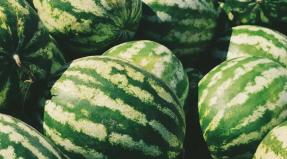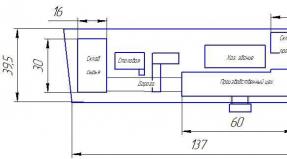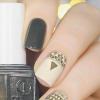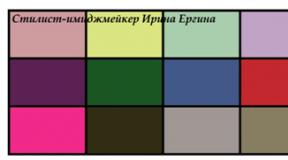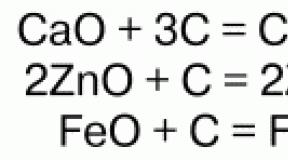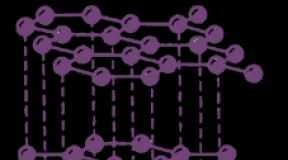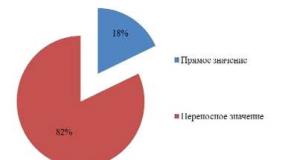Partial atrophy of the optic nerve (chazn). One of the most common reasons for visiting an ophthalmologist: eye injuries, their types Coding and lateralization
Fortunately, pathology optic nerve, - conductor of electrochemical signals from the retina to visual cortex brain - in ophthalmic practice is relatively rare; according to medical statistics, the proportion of such pathology in the total flow of eye diseases does not exceed 1-1.5%. However, every fifth (according to other sources, every fourth) of these cases ends in irreversible blindness due to atrophy of the optic nerve.
Atrophy, - “optic neuropathy”, organic degeneration of the neuronal fibers of the optic nerve due to a pronounced deficiency in its nutrition and blood supply, can be either complete or partial. In the latter case, there is a deep decrease in all visual functions, including color perception disorders, narrowing of the visual fields, etc.; with ophthalmoscopy, extending into the macular area of the retina (" yellow spot”, the most sensitive to light), the optic disc looks paler than usual.
Causes of optic nerve atrophy
The etiological causes of optic neuropathy can be various chronic or acute diseases eye, pathology of the central nervous system, ophthalmotrauma, general intoxication, severe systemic diseases (endocrine, autoimmune, etc.).
Among the actual ophthalmopathic factors, under the influence of which atrophy of the optic nerve can begin, glaucoma is in the lead. various forms; pigmentary retinal (retinal) dystrophy; all kinds of blockages of the arteries supplying the retina and efferent veins (for example, occlusion of the CAS, the central retinal artery); severe myopia; uveitis, retinitis, neuritis, orbital vasculitis and other inflammations. In addition, the optic nerve can become involved and atrophy during the development of oncopathology, in particular, with primary orbital cancer, meningioma or glioma of the optic nerve, neurinoma or neurofibroma, osteosarcoma, sarcoidosis.
CNS diseases that provoke or “trigger” atrophic processes in the optic nerve include mainly pituitary tumors, chiasms (compressing the optic chiasm), infectious and inflammatory processes meninges(encephalitis, meningitis, arachnoiditis) and general brain abscess, demyelinating diseases (eg, multiple sclerosis), craniocerebral injuries and wounds in maxillofacial region, especially with direct mechanical damage to the optic nerve.

In some cases, systemic atherosclerosis, chronic malnutrition and malnutrition, beriberi and anemia, poisoning become a provoking background and pathogenic ground for optic neuropathy. toxic substances(the most striking examples are frequent methyl poisoning when using surrogate alcoholic beverages, as well as intoxication with nicotine, insecticides, drugs), massive blood loss (for example, with extensive internal hemorrhages), diabetes and other endocrinopathy, lupus erythematosus, Wegener's granulomatosis and other autoimmune disorders.
In some cases, the optic nerve is atrophied already at birth (as a rule, this occurs in severe chromosomal pathology with gross skeletal and cranial deformities, for example, in acro-, micro- and macrocephaly, Crouzon's disease and other genetically determined anomalies of intrauterine development.
Finally, the proportion of cases (up to 20%) is quite large, when the direct causes of optic nerve atrophy cannot be established.
Classification of optic nerve atrophy
As shown above, optic neuropathy can be either congenital or acquired. In accordance with this, hereditary forms are distinguished, classifying them according to the type of inheritance: autosomal dominant, autosomal recessive, mitochondrial.
Autosomal dominant optic atrophy can be expressed in varying degrees and in some cases is observed in combination with congenital deafness. Autosomal recessive atrophy is included in the structure of a number of chromosomal syndromes (Wolfram, Kenny-Coffey, Jensen, Rosenberg-Chattorian syndromes, etc.).
Mitochondrial atrophy occurs when mitochondrial DNA is mutated (Leber's hereditary optic neuropathy).
Acquired optic neuropathy can also develop for various reasons and different type. So, the basis of primary atrophy is long-term mechanical compression of the neural optic canal, while the optic nerve head in the study of the fundus may look intact, undamaged, with normatively clear boundaries.
Secondary atrophy may be the result of swelling of the optic disc, which, in turn, is one of the consequences of the pathology of the retina or the nerve itself. The degeneration and displacement of specialized, functional neuronal tissue by neuroglial tissue has more pronounced and obvious ophthalmoscopic correlates: the observed optic nerve head in this case, as a rule, is enlarged in diameter, its borders lose their clarity. In glaucoma, the axial symptom of which is chronic high blood pressure intraocular fluid, the developing collapse of the cribriform plate of the sclera leads to atrophy of the optic nerve.
The observed shade of the optic disc is of significant diagnostic value. So, the initial, partial and complete atrophy of the optic nerve during ophthalmoscopy look different: in initial stage there is a slight blanching of the disc with the usual color of the nerve itself, with partial - the optic nerve disc turns pale in separate segments, and finally, complete atrophy is observed as a total and uniform blanching of the optic disc in combination with a narrowing of the blood vessels supplying the fundus.
There are also ascending and descending forms of atrophy (with ascending, the atrophic process in the nerve is initiated by damage to the retinal tissue, with descending, it begins in the fibers of the optic nerve itself). Depending on the prevalence of the process, atrophy is divided into one- and two-sided; according to the nature of development - into stationary (stable) and progressive, which can be diagnosed by regular ophthalmological observations in dynamics.

ICD-10 code
V international classification diseases of the tenth revision (ICD 10) optic nerve atrophy has the code H 47.2
Symptoms of atrophy
One of the main signs of incipient atrophy of the optic nerve is an uncorrected decrease in visual acuity and quality: neither glasses nor contact lenses can compensate for the decrease in visual functions caused by the atrophic process in the nerve. Rapidly progressive optic nerve atrophy can result in complete, incurable blindness after several months or even days. With partial atrophy, organic degradation and increasing functional failure of the organs of vision stop at a certain level and stabilize (the reasons for such stabilization often also remain unclear).
Fields of vision are narrowed, as a rule, due to the loss of peripheral ("lateral") vision - the so-called. tunnel vision syndrome. Violations of color perception relate mainly to the red-green and yellow-blue gradients of the general spectrum. Scotomas may appear, i.e. blind spots in the field of relatively intact vision.
Quite typical for optic neuropathy is the so-called. pupillary defect: weakening of the pupil's reaction to light while maintaining overall concordance pupillary reactions. Pupillary defect can be unilateral or be detected in both eyes at the same time.
Whatever symptoms accompany optic nerve atrophy, they should be ascertained only during a professional ophthalmoscopic examination and interpreted by a qualified ophthalmologist.
Diagnosis
In addition to visual ophthalmoscopy, any information related to the premorbid (pre-painful) period of a patient's life can acquire decisive diagnostic value: pharmacological group and dosage of previous medicines, previous intoxications and general diseases, self-destructive habits (smoking, alcohol abuse, unhealthy lifestyle), traumatic brain injury experienced (traumatic brain injury), background residual pathology of the central nervous system, etc.
Direct examination includes a statement or exclusion of exophthalmos ("bulging", displacement eyeball anteriorly), the study of pupillary and corneal reflexes, the mobility of the eyeball, general acuity and visual fields (visimetry, perimetry), diagnostics of color perception.
As indicated above, one of the most informative diagnostic criteria is the appearance of the optic nerve head during ophthalmoscopy of the fundus: color, clarity of boundaries, diameter, uniformity, deformation, excavation ("pitting") of the surface of the optic disc, Kestenbaum's symptom (reduction of the usual number of small capillaries by disk), caliber, shade and linearity/tortuosity of retinal arteries and veins. You may also need additional tomographic examination in one mode or another (laser scanning, optical coherence tomography), an electrophysiological study to measure the thresholds of sensitivity and lability of the optic nerve. With atrophy caused by glaucoma, it is mandatory to measure and control IOP (intraocular pressure), incl. in daily and load modes.
Volumetric orbital oncopathology is diagnosed by the method plain radiography. If necessary, a detailed study of circulation and hemodynamics in vascular system fluorescein angiography (one of the methods of contrast radiography) and / or ultrasound in the Doppler version is prescribed. In order to clarify the diagnosis, consultants of related specialties are involved, primarily neurologists, oncologists, neurosurgeons, in the presence of systemic vasculitis - rheumatologists, etc.; visualizing methods for examining the skull and brain (X-ray, CT, MRI) are prescribed.
Occlusions of retinal vessels (arteries, veins) require the involvement of a vascular surgeon. In the presence of infectious symptoms, laboratory tests (ELISA, PCR) are prescribed.
Optic atrophy should be differentiated from peripheral cataract (clouding of the lens) and amblyopia ("lazy eye syndrome").

Treatment of partial atrophy of the optic nerve
The principle of etiopathogenetic medicine requires the identification and elimination of the causes of the disease as much as possible; Since optic neuropathy is much more likely to be a consequence and manifestation of other diseases than an autonomous and isolated pathology, the therapeutic strategy should begin with the treatment of the underlying disease.
In particular, for patients with intracranial (intracranial) oncopathology, hypertension, established aneurysms of cerebral vessels, it is recommended, first of all, neurosurgical intervention of the appropriate direction.
Conservative treatment for optic nerve atrophy focuses on stabilizing and maintaining the functional status of the visual system to the extent that this is possible in this particular case. So, various decongestant and anti-inflammatory measures can be shown, in particular, retro- or parabulbar injections (administration of dexamethasone preparations, respectively, behind or next to the eyeball), droppers with glucose and calcium chloride solutions, diuretics (diuretics, for example, lasix). According to indications, injections of hemodynamic and optic nerve stimulants (trental, xanthinol nicotinate, atropine) are also prescribed, a nicotinic acid intravenously, eufillin; vitamin complexes(vitamins of group B are especially important), extracts of aloe and vitreous body, tableted cinnarizine, piracetam, etc. In glaucoma symptoms, drugs are used that reduce intraocular pressure(e.g. pilocarpine instillations).
Physiotherapeutic methods, such as acupuncture, laser or electrical stimulation, various modifications of the electrophoresis technique, magnetotherapy, etc., are quite effective for optic nerve atrophy. However, if the vision is reduced deeper than to 0.01, any measures taken are, unfortunately, ineffective.
Prediction and prevention of optic nerve atrophy
The degree of curability and the possibility of rehabilitation in almost any ophthalmopathology depends decisively on how timely the patient applied and how qualified, accurate and complete the diagnosis was. If adequate treatment begins at the earliest early stages atrophy of the optic nerve, it is quite possible to stabilize, and in some cases, partial rehabilitation of visual functions. Their complete recovery today remains beyond the scope of the available therapeutic possibilities. With rapidly progressive atrophy, total blindness is a very likely outcome.
A preventive measure that is effective against optic nerve atrophy is "only" timely treatment any acute or chronic diseases, no matter what system of the body they concern: visual, nervous, musculoskeletal, immune, endocrine, etc. Of course, intoxications should be avoided, especially the voluntary poisonings described above with alcohol or nicotine. Any massive blood loss requires adequate compensation.
And, of course, even a slight tendency to deterioration of vision requires an immediate consultation with an ophthalmologist.
CLASS VII. Diseases of the eye and adnexa (H00-H59)
This class contains the following blocks:
H00-H06 Diseases of the eyelids, lacrimal ducts and eye sockets
H10-H13 Diseases of the conjunctiva
H15-H22 Diseases of the sclera, cornea, iris and ciliary body
H25-H28 Diseases of the lens
H30-H36 Diseases of the choroid and retina
H40-H42 Glaucoma
H43-H45 Diseases of the vitreous body and the eyeball
H46-H48 Diseases of the optic nerve and visual pathways
H49-H52 Diseases of the muscles of the eye, disorders of friendly eye movement, accommodation and refraction
H53-H54 Visual disturbances and blindness
H55-H59 Other diseases of the eye and adnexa
The following categories are marked with an asterisk:
H03* Eyelid lesions in diseases,
H06* Disorders of the lacrimal apparatus and orbit in diseases classified elsewhere
H13* Disorders of the conjunctiva in diseases classified elsewhere
H19* Affections of the sclera and cornea in diseases classified elsewhere
H22* Iris and ciliary body disorders in diseases classified elsewhere
H28* Cataracts and other lesions of the lens in diseases classified elsewhere
H32* Chorioretinal disorders in diseases classified elsewhere
H36* Retinal disorders in diseases classified elsewhere
H42* Glaucoma in diseases classified elsewhere
H45* Disorders of the vitreous body and the eyeball in diseases classified elsewhere
H48* Disorders of the optic nerve and optic pathways in diseases classified elsewhere
H58* Other disorders of the eye and adnexa in diseases classified elsewhere
DISEASES OF THE EYELIDS, TLAMIC DUCTS AND EYES (H00-H06)
H00 Hordeolum and chalazion
H00.0 Hordeolum and other deep inflammations of the eyelids
abscess)
Furuncle) century
barley)
H00.1 Chalazion
H01 Other eyelid inflammations
H01.0 Blepharitis
Excludes: blepharoconjunctivitis ( H10.5)
H01.1 Non-infectious eyelid dermatoses
Dermatitis:
allergic)
pin)
eczematous) century
Discoid lupus erythematosus)
Xeroderma)
H01.8 Other inflammations of the eyelid, specified
H01.9 Inflammation of eyelid, unspecified
H02 Other diseases of the eyelids
Excludes: congenital malformations of eyelid ( Q10.0-Q10.3)
H02.0 Entropion and trichiasis of the century
H02.1 Ectropion of the century
H02.2 Lagophthalmos
H02.3 Blepharochalasis
H02.4 Ptosis of the eyelid
H02.5 Other diseases that disrupt the function of the eyelid
Ankyloblepharon. Blepharophimosis. Wrinkling of the eyelid
Excludes: blepharospasm ( G24.5)
tick (psychogenic) ( F95. -)
organic ( G25.6)
H02.6 Xanthelasma of the eyelid
H02.7 Other degenerative diseases of the eyelid and periocular region
Chloasma)
Madarose) century
Vitiligo)
H02.8 Other specified diseases of the eyelid. Hypertrichosis of the century. Unremoved foreign body in the century
H02.9 Disease of the eyelid, unspecified
H03* Eyelid disorders in diseases classified elsewhere
H04 Diseases of the lacrimal apparatus
Excludes: congenital malformations of the lacrimal apparatus ( Q10.4-Q10.6)
H04.0 Dacryoadenitis. Chronic hypertrophy of the lacrimal gland
H04.1 Other diseases of the lacrimal gland. Dacryops. dry eye syndrome
Lacrimal gland:
cyst
atrophy
H04.2 Epiphora
H04.3 Acute and unspecified inflammation tear ducts. Dacryocystitis (phlegmatic)
Dacryopericystitis) acute, subacute or
Lacrimal canaliculitis, unspecified
Excludes: dacryocystitis of the newborn ( P39.1)
H04.4 Chronic inflammation of the tear ducts
Dacryocystitis)
Lacrimal gland: )
canaliculitis (chronic)
mucocele)
H04.5 Stenosis and insufficiency of the lacrimal ducts. Dacryolite. Eversion of the lacrimal opening
Lacrimal stenosis:
tubule
duct
bag
H04.6 Other changes in the lacrimal ducts. Lacrimal fistula
H04.8 Other diseases of the lacrimal apparatus
H04.9 Disease of the lacrimal apparatus, unspecified
H05 Diseases of the orbit
Excludes: congenital malformations of the orbit ( Q10.7)
H05.0 Acute eye inflammation
abscess)
cellulite)
Osteomyelitis) eye sockets
Periostitis)
Tenonite
H05.1 Chronic inflammatory diseases of the orbit. Orbital granuloma
H05.2 exophthalmic conditions
Displacement of the eyeball (external) NOS
hemorrhage)
Edema) eye sockets
H05.3 Eye socket deformity
atrophy)
Exostosis) eye sockets
H05.4 enophthalmos
H05.5 A foreign body that has not been removed long ago in the orbit due to a penetrating injury to the orbit
Retrobulbar foreign body
H05.8 Other diseases of the eye. Orbital cyst
H05.9 Eye disease, unspecified
H06* Disorders of the lacrimal apparatus and orbit in diseases classified elsewhere
DISEASES OF THE CONJUNCTIA (H10-H13)
H10 Conjunctivitis
H16.2)
H10.0 Mucopurulent conjunctivitis
H10.1 Acute atopic conjunctivitis
H10.2 Other acute conjunctivitis
H10.3 Acute conjunctivitis unspecified
Excludes: neonatal ophthalmia NOS ( P39.1)
H10.4 Chronic conjunctivitis
H10.5 Blepharoconjunctivitis
H10.8 Other conjunctivitis
H10.9 Conjunctivitis, unspecified
H11 Other disorders of conjunctiva
Excludes: keratoconjunctivitis ( H16.2)
H11.0 Pterygium
Excluded: pseudopterygium ( H11.8)
H11.1 Conjunctival degenerations and deposits
Conjunctival:
argyria
stones
pigmentation
xerosis NOS
H11.2 Scars of the conjunctiva. Simblefarone
H11.3 Conjunctival hemorrhage. Subconjunctival hemorrhage
H11.4 Other conjunctival vascular diseases and cysts
Conjunctival:
aneurysm
hyperemia
edema
H11.8 Other specified diseases of the conjunctiva. Pseudopterygium
H11.9 Disease of conjunctiva, unspecified
H13* Disorders of the conjunctiva in diseases classified elsewhere
H13.0* Filarial invasion of the conjunctiva ( B74. -+)
H13.1* Acute conjunctivitis in diseases classified elsewhere
Conjunctivitis (caused):
acanthamoeba ( B60.1+)
adenoviral follicular (acute) ( B30.1+)
chlamydial ( A74.0+)
diphtheria ( A36.8+)
gonococcal ( A54.3+)
hemorrhagic (acute) (epidemic) ( B30.3+)
herpesvirus ( B00.5
+)
meningococcal ( A39.8+)
Newcastle ( B30.8+)
herpes zoster ( B02.3+)
H13.2* Conjunctivitis in diseases classified elsewhere
H13.3* Ocular pemphigoid ( L12. -+)
H13.8* Other disorders of the conjunctiva in diseases classified elsewhere
DISEASES OF THE SCLERA, CORNEA, IRIS AND CILARY BODY (H15-H22)
H15 Diseases of the sclera
H15.0 Sclerite
H15.1 episcleritis
H15.8 Other lesions of the sclera. Equatorial staphyloma. Scleral ectasia
Excludes: degenerative myopia ( H44.2)
H15.9 Disease of sclera, unspecified
H16 Keratitis
H16.0 Corneal ulcer
Ulcer:
cornea:
NOS
central
regional
perforative
ring
with hypopyon
moray eel
H16.1 Other superficial keratitis without conjunctivitis
Keratitis:
areolar
filiform
coin-like
card-like
stellate
banded
superficial point
Photokeratitis
snow blindness
H16.2 Keratoconjunctivitis
Keratoconjunctivitis:
NOS
caused by external influence
neurotrophic
phlyctenular
Nodular [nodular] ophthalmia
Superficial keratitis with conjunctivitis
H16.3 Interstitial (stromal) and deep keratitis
H16.4 neovascularization of the cornea. Shadow-like vessels (corneal). Pannus (corneal)
H16.8 Other forms of keratitis
H16.9 Keratitis, unspecified
H17 Scarring and clouding of the cornea
H17.0 Adhesive leukoma
H17.1 Other central corneal opacities
H17.8 Other scars and corneal opacities
H17.9 Scars and opacities of the cornea, unspecified
H18 Other disorders of cornea
H18.0 Pigmentation and deposits in the cornea. Hemorrhage in the cornea. Kaiser-Fleischer ring
Krukenberg spindle. Stegli Line
H18.1 Bullous keratopathy
H18.2 Other corneal edema
H18.3 Corneal changes
crease)
Rupture) of the Descemet's shell
H18.4 Corneal degeneration. Elder arc. Band keratopathy
Excluded: Moray ulcer ( H16.0)
H18.5 Hereditary corneal dystrophies
Dystrophy:
cornea:
epithelial
granular
lattice
spotted
Fuchs
H18.6 Keratoconus
H18.7 Other corneal deformities
Cornea:
ectasia
staphyloma
Descemetocele
Excludes: congenital malformations of the cornea ( Q13.3-Q13.4)
H18.8 Other specified diseases of the cornea
Anesthesia)
Hypesthesia) of the cornea
recurrent erosion)
H18.9 Corneal disease, unspecified
H19* Disorders of sclera and cornea in diseases classified elsewhere
H20 Iridocyclitis
H20.0 Acute and subacute iridocyclitis
anterior uveitis)
Cyclitis) acute recurrent or subacute
Irit)
H20.1 Chronic iridocyclitis
H20.2 Iridocyclitis caused by lenses
H20.8 Other iridocyclitis
H20.9 Iridocyclitis, unspecified
H21 Other disorders of iris and ciliary body
H22* Disorders of the iris and ciliary body in diseases
classified elsewhere
H22.0* Iridocyclitis in infectious diseases classified elsewhere
Iridocyclitis with:
gonococcal infection ( A54.3+)
herpes virus infection B00.5+)
syphilis (secondary) ( A51.4+)
tuberculosis ( A18.5+)
shingles ( B02.3+)
H22.1* Iridocyclitis in diseases classified elsewhere
Iridocyclitis with:
ankylosing spondylitis ( M45+)
sarcoidosis ( D86.8+)
H22.8* Other lesions of the iris and ciliary body in diseases classified elsewhere
DISEASES OF THE LENS (H25-H28)
H25 Senile cataract
Excludes: capsular glaucoma with false detachment of the lens ( H40.1)
H25.0 Primary senile cataract
Senile cataract:
coronary
cortical
point
Subcapsular polar senile cataract (anterior) (posterior). water slots
H25.1 Senile nuclear cataract. Brown cataract. Nuclear sclerotic cataract
H25.2 Senile morganian cataract. Senile overripe cataract
H25.8 Other senile cataracts. Combined forms of senile cataract
H25.9 Senile cataract, unspecified
H26 Other cataracts
Excluded: congenital cataract (Q12.0)
H26.0 Pediatric, juvenile and presenile cataracts
H26.1 Traumatic cataract
Use an additional code if necessary to identify the cause. external causes(class XX).
H26.2 Complicated cataract. Cataract in chronic iridocyclitis
Secondary cataract at eye diseases. Glaucomatous flecks (subcapsular)
H26.3 Drug-induced cataract
If necessary, to identify the drug that caused the lesion, use an additional external cause code (class XX).
H26.4 Secondary cataract. Secondary cataract. Semmering ring
H26.8 Other specified cataract
H26.9 Cataract, unspecified
H27 Other disorders of lens
Excludes: congenital malformations of the lens ( Q12. -)
mechanical complications associated with the implanted lens ( T85.2)
pseudophakia ( Z96.1)
H27.0 Afakia
H27.1 Dislocation of the lens
H27.8 Other specified diseases of the lens
H27.9 Disease of lens, unspecified
H28* Cataract and other disorders of the lens in diseases classified elsewhere
H28.0* Diabetic cataract ( E10-E14+ with a common fourth sign.3)
H28.1* Cataract in other diseases endocrine system, eating disorders and metabolic disorders,
classified elsewhere
cataract in hypoparathyroidism E20. -+)
Cataracts due to malnutrition and dehydration ( E40-E46+)
H28.2* Cataract in other diseases classified elsewhere
Myotonic cataract ( G71.1+)
H28.8* Other disorders of the lens in diseases classified elsewhere
DISEASES OF THE VASCULAR AND RETINA (H30-H36)
H30 Chorioretinal inflammation
H30.0 Focal chorioretinal inflammation
Focal:
chorioretinitis
choroiditis
retinitis
retinochoroiditis
H30.1 Disseminated chorioretinal inflammation
Disseminated:
chorioretinitis
choroiditis
retinitis
retinochoroiditis
Excludes: exudative retinopathy ( H35.0)
H30.2 Rear cycle. Pars planitis
H30.8 Other chorioretinal inflammations. Harad disease
H30.9 Chorioretinal inflammation, unspecified
Chorioretinitis)
choroiditis)
Retinitis NOS
Retinochoroiditis)
H31 Other disorders of choroid
H31.0 Chorioretinal scars
Macular scars of the posterior pole (post-inflammatory) (post-traumatic). solar retinopathy
H31.1 Degeneration of the choroid of the eye
atrophy)
Sclerosis) of the choroid of the eye
Excludes: angioid strips ( H35.3)
H31.2 Hereditary dystrophy of the choroid of the eye. Choroiderma
Choroidal dystrophy (central areolar) (generalized) (peripapillary)
Ring-shaped atrophy of the choroid of the eye
Excludes: ornithinemia ( E72.4)
H31.3 Hemorrhage and rupture of the choroid of the eye
Choroidal hemorrhage:
NOS
expulsive
H31.4 Detachment of the choroid of the eye
H31.8 Other specified diseases of the choroid of the eye
H31.9 Disease of choroid, unspecified
H32* Chorioretinal disorders in diseases classified elsewhere
H32.0* Chorioretinal inflammation in infectious and parasitic diseases classified elsewhere
Chorioretinitis:
syphilitic late ( A52.7+)
toxoplasmosis ( B58.0+)
tuberculosis ( A18.5+)
H32.8* Other chorioretinal disorders in diseases classified elsewhere
H33 Retinal detachment and breaks
H34 Occlusion of retinal vessels
G45.3)
H34.0 Transient retinal arterial occlusion
H34.1 Central retinal arterial occlusion
H34.2 Other retinal arterial occlusions
Spot [plaque] of Hollenhorst
Retinal:
arterial occlusion:
branches
partial
microembolism
H34.8 Other retinal vascular occlusions
Retinal venous occlusion:
central
initial
partial
venous branch
H34.9 Retinal vascular occlusion, unspecified
H35 Other disorders of retina
H35.0 Background retinopathy and retinal vascular changes
Changes in the retinal vascular pattern
Retinal:
microaneurysms
neovascularization
perivasculitis
varicose veins
vascular cases
vasculitis
Retinopathy:
NOS
background NOS
Coates
exudative
hypertensive
H35.1 Preretinopathy. Retrolental fibroplasia
H35.2 Other proliferative retinopathy. Proliferative vitreoretinopathy
H33.4)
H35.3 Macular and posterior pole degeneration
angioid streaks)
cyst)
Drusen (degenerative) macula
hole)
wrinkling)
Kunt-Junius degeneration
Senile macular degeneration (atrophic) (exudative). Toxic maculopathy
If necessary, to identify the drug that caused the lesion, use an additional external cause code (class XX).
H35.4 Peripheral retinal degenerations
retinal degeneration:
NOS
lattice
microcystic
palisade
reminiscent of appearance cobblestone pavement
reticular
Excluded: with retinal tear ( H33.3)
H35.5 Hereditary retinal dystrophies
Dystrophy:
retinal (albipunctate) (pigmented) (yolk-like)
tapetoretinal
vitreoretinal
Pigmentary retinitis. Stargardt disease
H35.6 Retinal hemorrhage
H35.7 Splitting of the layers of the retina. Central serous chorioretinopathy. Detachment of the retinal pigment epithelium
H35.8 Other specified retinal disorders
H35.9 Retinal disease, unspecified
H36* Retinal disorders in diseases classified elsewhere
H36.0* Diabetic retinopathy ( E10-E14+ with a common fourth sign.3)
H36.8* Other retinal disorders in diseases classified elsewhere
atherosclerotic retinopathy ( I70.8+)
proliferative sickle cell retinopathy ( D57. -+)
Retinal dystrophy in lipid storage diseases ( E75. -+)
GLAUCOMA (H40-H42)
H40 Glaucoma
Excludes: absolute glaucoma ( H44.5)
congenital glaucoma ( Q15.0)
traumatic glaucoma due to birth trauma ( P15.3)
H40.0 Suspicion of glaucoma. Ocular hypertension
H40.1 Primary open-angle glaucoma
Glaucoma (primary) (residual stage):
capsular with false detachment of the lens
chronic simple
low pressure
pigmented
H40.2 Primary angle-closure glaucoma
Angle-closure glaucoma (primary) (residual stage):
acute
chronic
intermittent
H40.3 Glaucoma secondary post-traumatic
H40.4 Glaucoma secondary to inflammatory disease of the eye
Use an additional code if necessary to identify the cause.
H40.5 Glaucoma secondary to other eye diseases
Use an additional code if necessary to identify the cause.
H40.6 Secondary glaucoma caused by drugs
If necessary, identify medicinal product that caused the defeat, use an additional code of external causes (class XX).
H40.8 Other glaucoma
H40.9 Glaucoma, unspecified
H42* Glaucoma in diseases classified elsewhere
H42.0* Glaucoma in diseases of the endocrine system, eating disorders and metabolic disorders
Glaucoma with:
amyloidosis ( E85. -+)
low's syndrome E72.0+)
H42.8* Glaucoma in other diseases classified elsewhere
Glaucoma in onchocerciasis ( B73+)
DISEASES OF THE VITERAL BODY AND EYEBALL (H43-H45)
H43 Disorders of the vitreous body
H43.0 Vitreous prolapse (prolapse)
Excludes: vitreous body syndrome after cataract surgery ( H59.0)
H43.1 Vitreous hemorrhage
H43.2 Crystal deposits in the vitreous
H43.3 Other vitreous opacities
H43.8 Other diseases of the vitreous body
vitreous body:
degeneration
detachment
Excludes: proliferative vitreoretinopathy with retinal detachment ( H33.4)
H43.9 Vitreous body disease, unspecified
H44 Diseases of the eyeball
H45* Disorders of the vitreous body and the eyeball in diseases classified elsewhere
H45.0* Vitreous hemorrhage in diseases classified elsewhere
H45.1* Endophthalmitis in diseases classified elsewhere
Endophthalmitis with:
cysticercosis ( B69.1+)
onchocerciasis ( B73+)
toxocariasis ( B83.+)
H45.8* Other disorders of the vitreous body and the eyeball in diseases classified elsewhere
DISEASES OF THE OPTIC NERVE AND VISUAL TRACTS (H46-H48)
H46 Optic neuritis
Optical(s):
neuropathy other than ischemic
papillitis
Retrobulbar neuritis NOS
Excludes: ischemic optic neuropathy ( H47.0)
optic neuromyelitis [Devika] ( G36.0)
H47 Other disorders of optic nerve and visual pathways
H47.0 Diseases of the optic nerve, not elsewhere classified
Compression of the optic nerve. Hemorrhage in the sheath of the optic nerve. Ischemic neuropathy optic nerve
H47.1 Optic disc edema, unspecified
H47.2 Atrophy of the optic nerve. Paleness of the temporal half of the optic disc
H47.3 Other diseases of the optic disc
Growth on the optic nerve head. False papilledema
H47.4 Optic chiasm lesions
H47.5 Lesions of other parts of the visual pathways
Diseases of the optic tracts, geniculate nucleus and optic radiation area
H47.6 Visual cortical lesions
H47.7 Disorders of optic pathways, unspecified
H48* Disorders of optic nerve and optic pathways in diseases classified elsewhere
H48.0* Atrophy of the optic nerve in diseases classified elsewhere
Optic nerve atrophy in late syphilis ( A52.1+)
H48.1* Retrobulbar neuritis in diseases classified elsewhere
Retrobulbar neuritis with:
late syphilis ( A52.1+)
meningococcal infection ( A39.8+)
multiple sclerosis ( G35+)
H48.8* Other disorders of the optic nerve and optic pathways in diseases classified elsewhere
EYE MUSCLES DISEASES, CONTINUOUS EYE MOTION DISORDERS, ACCOMMODATION AND REFRACTION
(H49-H52)
Excludes: nystagmus and other involuntary eye movements ( H55)
H49 Paralytic strabismus
Excludes: ophthalmoplegia:
internal ( H52.5)
intranuclear ( H51.2)
supranuclear progressive ( G23.1)
H49.0 Paralysis of the 3rd [oculomotor] nerve
H49.1 Paralysis of the 4th [trochlear] nerve
H49.2 Paralysis of the 6th [abducens] nerve
H49.3 Complete (external) ophthalmoplegia
H49.4 Progressive external ophthalmoplegia
H49.8 Other paralytic strabismus. External ophthalmoplegia NOS. Cairns-Sayre syndrome
H49.9 Paralytic strabismus, unspecified
H50 Other forms of strabismus
H50.0 Convergent concomitant strabismus. Esotropia (alternating) (monocular), except intermittent
H50.1 Divergent concomitant strabismus. Exotropia (alternating) (monocular), except intermittent
H50.2 Vertical strabismus
H50.3 Intermittent heterotropia
Intermittent:
esotropia)
exotropia) alternating (monocular)
H50.4 Other and unspecified heterotropies. Concomitant strabismus NOS
Cyclotropy. Hypertropia. Hypotropia. Microtropia. Monofixation Syndrome
H50.5 Heterophoria. Alternating heterophoria. Esophoria. Exophoria
H50.6 Mechanical strabismus. Brown's capsule syndrome. Strabismus due to adhesions
Traumatic restriction of the elasticity of the eye muscle
H50.8 Other specified types of strabismus. Duane syndrome
H50.9 Strabismus, unspecified
H51 Other concomitant eye movement disorders
H51.0 Gaze paralysis
H51.1 Lack of convergence [convergence under and over]
H51.2 Intranuclear ophthalmoplegia
H51.8 Other specified concomitant eye movement disorders
H51.9 Concomitant eye movement disorder, unspecified
H52 Disorders of refraction and accommodation
H52.0 Hypermetropia
H52.1 Myopia
Excludes: malignant myopia ( H44.2)
H52.2 Astigmatism
H52.3 Anisometropia and aniseikonia
H52.4 Presbyopia
H52.5 Accommodation disorders
Internal ophthalmoplegia (complete) (total)
paresis)
Spasm) accommodation
H52.6 Other refractive errors
H52.7 Refractive error, unspecified
VISUAL DISORDERS AND BLINDNESS (H53-H54)
H53 Visual disturbances
H53.0 Amblyopia due to anopsia
Amblyopia due to:
anisometropia
visual deprivation
strabismus
H53.1 Subjective visual disorders
Asthenopia. Day blindness. Hemeralopia. Metamorphopsia. Photophobia. Flickering scotoma. Sudden vision loss
Visual rainbow rings
Excludes: visual hallucinations ( R44.1)
H53.2 Diplopia. Image doubling
H53.3 Other violations binocular vision. Image mismatch on the retina
Fusion of images at stereoscopic defect. Simultaneous visual perception without image fusion
Oppression of binocular vision
H53.4 visual field defects. Expanded blind spot. Generalized narrowing of the visual field
Hemionopsia (opposite) (of the same name). quadrant anopia
Scotoma:
arched
Bjerrum
central
annular
H53.5 Color vision anomalies. Achromatopsia. Acquired color vision deficiency. color blindness
Deuteranomaly. Deuteranopia. Protanomaly. Protanopia. Tritanomaly. Tritanopia
Excludes: day blindness ( H53.1)
H53.6 night blindness
Excluded: due to lack of vitamin A ( E50.5)
H53.8 Other visual disorders
H53.9 Visual disturbance, unspecified
H54 Blindness and decreased vision
Note See the following table to define visual impairment categories.
Excludes: transient blindness ( G45.3)
H54.0 Blindness in both eyes. Category 3, 4, 5 visual impairment in both eyes
H54.1 Blindness in one eye, decreased vision in the other eye
Visual impairment category 3, 4, 5 in one eye and category 1 or 2 in the other eye
H54.2 Decreased vision in both eyes. Category 1 or 2 visual impairment in both eyes
H54.3 Indefinite loss of vision in both eyes. Category 9 visual impairment in both eyes
H54.4 Blindness in one eye. Category 3, 4, 5 visual impairment in one eye [normal visual acuity in the other eye]
H54.5 Reduced vision in one eye. Category 1 or 2 visual impairment in one eye [normal visual acuity in the other eye]
H54.6 Indefinite loss of vision in one eye. Category 9 visual impairment in one eye [normal visual acuity in the other eye]
H54.7 Unspecified vision loss. Category 9 visual impairment NOS
Note The following table shows the classification of the degree of visual impairment recommended by
WHO Scientific Group on the Prevention of Blindness, Geneva, 6-10 November 1972 (WHO Technical Report Series, N51 8, 1974).
The term "low vision" in the rubric H54 covers categories 1 and 2 of the table below, the term "blindness" covers categories 3, 4 and 5, and the term "indefinite loss of vision" covers category 9. If the limits of the visual field are also taken into account, then patients with a field of view no more than 10 degrees, but more than 5 degrees around the central visual axis, should be classified as category 3, and patients with a visual field of not more than 5 degrees around the central axis should be classified as category 4, even if the central visual acuity is not impaired.
Category Visual acuity with the highest possible correction
visual impairment maximum value minimum value
less than equal or more than
1 6/18 6/60
3/10 (0,3) 1/10 (0,1)
20/70 20/200
2 6/60 3/60
1/10 (0,1) 1/20 (0,5)
20/200 20/400
3 3/60 1/60 (finger count
at a distance of 1 m)
1/20 (0,05) 1/50 (0,02)
20/400 5/300 (20/1200)
4 1/60 (finger count
at a distance of 1m) Light perception
1/50 (0,02)
5/300
5 Lack of light perception
9 Unspecified or unspecified
OTHER DISEASES OF THE EYE AND ITS Adnexa (H55-H59)
H55 Nystagmus and other involuntary eye movements
Nystagmus:
NOS
congenital
as a result of visual deprivation
disunited
latent
H57 Other diseases of the eye and adnexa
H57.0 Anomalies of pupillary function
H57.1 eye pain
H57.8 Other unspecified diseases eyes and adnexa
H57.9 Disorder of eye and adnexa, unspecified
H58* Other disorders of eye and adnexa in diseases classified elsewhere
H58.0* Anomalies of pupillary function in diseases classified elsewhere
Phenomenon or pupil of Argyle Robertson syphilitic ( A52.1+)
H58.1* Visual impairment in diseases classified elsewhere
H58.8* Other disorders of the eye and adnexa in diseases classified elsewhere
Syphilitic oculopathy NEC:
congenital
early ( A50.0+)
late ( A50.3+)
early (secondary) ( A51.4+)
late ( A52.7+)
H59 Disorders of the eye and adnexa following medical procedures
Excludes: mechanical complication from:
intraocular lens ( T85.2)
other ocular prosthetic devices, implant
and transplant ( T85.3)
pseudophakia ( Z96.1)
H59.0 Vitreous body syndrome after cataract surgery
H59.8 Other lesions of the eye and adnexa after medical procedures
Chorioretinal scars after surgery for retinal detachment
H59.9 Damage to the eye and adnexa after medical procedures, unspecified
Full decoding of the ICD code H00-H59:
ICD code online / Code ICD H00-H59/ International Classification of Diseases / Diseases of the eye and adnexa
Table of contents [Show]
ICD 10. CLASS VII. Diseases of the eye and adnexa (H00-H59)
H00-H06
H10-H13 Diseases of the conjunctiva
H15-H22
H25-H28 Diseases of the lens
H30-H36
H40-H42 Glaucoma
H43-H45
H46-H48
H49-H52
H53-H54
H55-H59
H03* Eyelid lesions in diseases,
H06
H13
H19
H22
H28
H32
H36
H42
H45
H48
H58
H00 Hordeolum and chalazion
H00.0
abscess)
Furuncle) century
barley)
H00.1 Chalazion
H01.0 Blepharitis
H10.5)
H01.1
Dermatitis:
allergic)
pin)
eczematous) century
Xeroderma)
H01.8
H01.9 Inflammation of eyelid, unspecified
Q10.0-Q10.3)
H02.0 Entropion and trichiasis of the century
H02.1 Ectropion of the century
H02.2 Lagophthalmos
H02.3 Blepharochalasis
H02.4 Ptosis of the eyelid
H02.5
Excludes: blepharospasm ( G24.5)
tick (psychogenic) ( F95. -)
organic ( G25.6)
H02.6 Xanthelasma of the eyelid
H02.7
Chloasma)
Madarose) century
Vitiligo)
H02.8
H02.9 Disease of the eyelid, unspecified
Q10.4-Q10.6)
H04.0
H04.1
Lacrimal gland:
cyst
atrophy
H04.2 Epiphora
H04.3
P39.1)
H04.4
Dacryocystitis)
Lacrimal gland: )
canaliculitis (chronic)
mucocele)
H04.5
Lacrimal stenosis:
tubule
duct
bag
H04.6
H04.8
H04.9
Q10.7)
H05.0 Acute eye inflammation
abscess)
cellulite)
Osteomyelitis) eye sockets
Periostitis)
Tenonite
H05.1
H05.2 exophthalmic conditions
hemorrhage)
Edema) eye sockets
H05.3 Eye socket deformity
atrophy)
Exostosis) eye sockets
H05.4 enophthalmos
H05.5
H05.8
H05.9
H10 Conjunctivitis
H16.2)
H10.0
H10.1
H10.2 Other acute conjunctivitis
H10.3
P39.1)
H10.4 Chronic conjunctivitis
H10.5 Blepharoconjunctivitis
H10.8 Other conjunctivitis
H10.9 Conjunctivitis, unspecified
Excludes: keratoconjunctivitis ( H16.2)
H11.0 Pterygium
Excluded: pseudopterygium ( H11.8)
H11.1
Conjunctival:
argyria
stones
pigmentation
xerosis NOS
H11.2
H11.3
H11.4
Conjunctival:
aneurysm
hyperemia
edema
H11.8
H11.9
H13.0B74. -+)
H13.1
Conjunctivitis (caused):
acanthamoeba ( B60.1+)
B30.1+)
chlamydial ( A74.0+)
diphtheria ( A36.8+)
gonococcal ( A54.3+)
B30.3+)
herpesvirus ( B00.5
+)
meningococcal ( A39.8+)
Newcastle ( B30.8+)
herpes zoster ( B02.3+)
H13.2
H13.3* Ocular pemphigoid ( L12. -+)
H13.8
H15 Diseases of the sclera
H15.0 Sclerite
H15.1 episcleritis
H15.8
H44.2)
H15.9 Disease of sclera, unspecified
H16.0 Corneal ulcer
Ulcer:
cornea:
NOS
central
regional
perforative
ring
with hypopyon
moray eel
H16.1
Keratitis:
areolar
filiform
coin-like
card-like
stellate
banded
superficial point
Photokeratitis
snow blindness
H16.2 Keratoconjunctivitis
Keratoconjunctivitis:
NOS
neurotrophic
phlyctenular
Nodose ophthalmia
H16.3
H16.4
H16.8 Other forms of keratitis
H16.9 Keratitis, unspecified
H17.0 Adhesive leukoma
H17.1
H17.8
H17.9
H18.0
H18.1 Bullous keratopathy
H18.2 Other corneal edema
H18.3 Corneal changes
crease)
H18.4
Excluded: Moray ulcer ( H16.0)
H18.5
Dystrophy:
cornea:
epithelial
granular
lattice
spotted
Fuchs
H18.6 Keratoconus
H18.7
Cornea:
ectasia
staphyloma
Descemetocele
Q13.3-Q13.4)
H18.8
Anesthesia)
Hypesthesia) of the cornea
recurrent erosion)
H18.9
H20.0
anterior uveitis)
Irit)
H20.1 Chronic iridocyclitis
H20.2
H20.8 Other iridocyclitis
H20.9 Iridocyclitis, unspecified
classified elsewhere
H22.0
Iridocyclitis with:
gonococcal infection ( A54.3+)
herpes virus infection B00.5+)
syphilis (secondary) ( A51.4+)
tuberculosis ( A18.5+)
shingles ( B02.3+)
H22.1
Iridocyclitis with:
ankylosing spondylitis ( M45+)
sarcoidosis ( D86.8+)
H22.8
H25 Senile cataract
H40.1)
H25.0
Senile cataract:
coronary
cortical
point
H25.1
H25.2
H25.8
H25.9
Q12.0)
H26.0
H26.1 Traumatic cataract
H26.2
H26.3
If necessary, to identify the drug that caused the lesion, use an additional external cause code (class XX).
H26.4
H26.8 Other specified cataract
H26.9 Cataract, unspecified
Q12. -)
T85.2)
pseudophakia ( Z96.1)
H27.0 Afakia
H27.1 Dislocation of the lens
H27.8
H27.9
H28.0* Diabetic cataract ( E10-E14+ with a common fourth sign.3)
H28.1
classified elsewhere
E20. -+)
E40-E46+)
H28.2
Myotonic cataract ( G71.1+)
H28.8
H30 Chorioretinal inflammation
H30.0
Focal:
chorioretinitis
choroiditis
retinitis
retinochoroiditis
H30.1
Disseminated:
chorioretinitis
choroiditis
retinitis
retinochoroiditis
H35.0)
H30.2 Rear cycle. Pars planitis
H30.8
H30.9
Chorioretinitis)
choroiditis)
Retinitis NOS
Retinochoroiditis)
H31.0 Chorioretinal scars
H31.1
atrophy)
H35.3)
H31.2
Excludes: ornithinemia ( E72.4)
H31.3
Choroidal hemorrhage:
NOS
expulsive
H31.4
H31.8
H31.9
H32.0
Chorioretinitis:
syphilitic late ( A52.7+)
toxoplasmosis ( B58.0+)
tuberculosis ( A18.5+)
H32.8
G45.3)
H34.0
H34.1
H34.2
Hollenhorst spot
Retinal:
arterial occlusion:
branches
partial
microembolism
H34.8
central
initial
partial
venous branch
H34.9
H35.0
Retinal:
microaneurysms
neovascularization
perivasculitis
varicose veins
vascular cases
vasculitis
Retinopathy:
NOS
background NOS
Coates
exudative
hypertensive
H35.1
H35.2
H33.4)
H35.3
angioid streaks)
cyst)
hole)
wrinkling)
Kunt-Junius degeneration
If necessary, to identify the drug that caused the lesion, use an additional external cause code (class XX).
H35.4
retinal degeneration:
NOS
lattice
microcystic
palisade
reticular
H33.3)
H35.5
Dystrophy:
tapetoretinal
vitreoretinal
H35.6 Retinal hemorrhage
H35.7
H35.8
H35.9
H36.0* Diabetic retinopathy ( E10-E14+ with a common fourth sign.3)
H36.8
I70.8+)
D57. -+)
E75. -+)
H40 Glaucoma
H44.5)
congenital glaucoma ( Q15.0)
P15.3)
H40.0
H40.1
chronic simple
low pressure
pigmented
H40.2
acute
chronic
intermittent
H40.3
H40.4
Use an additional code if necessary to identify the cause.
H40.5
Use an additional code if necessary to identify the cause.
H40.6
H40.8 Other glaucoma
H40.9 Glaucoma, unspecified
H42.0
Glaucoma with:
amyloidosis ( E85. -+)
low's syndrome E72.0+)
H42.8
Glaucoma in onchocerciasis ( B73+)
H43 Disorders of the vitreous body
H43.0
H59.0)
H43.1
H43.2
H43.3
H43.8
vitreous body:
degeneration
detachment
Excludes: proliferative vitreoretinopathy with retinal detachment ( H33.4)
H43.9
H45.0
H45.1
Endophthalmitis with:
cysticercosis ( B69.1+)
onchocerciasis ( B73+)
toxocariasis ( B83.+)
H45.8
H46 Optic neuritis
Optical(s):
neuropathy other than ischemic
papillitis
Retrobulbar neuritis NOS
H47.0)
G36.0)
H47.0
H47.1
H47.2
H47.3
H47.4
H47.5
H47.6
H47.7
H48.0
A52.1+)
H48.1
Retrobulbar neuritis with:
late syphilis ( A52.1+)
meningococcal infection ( A39.8+)
multiple sclerosis ( G35+)
H48.8
H55)
Excludes: ophthalmoplegia:
internal ( H52.5)
intranuclear ( H51.2)
supranuclear progressive ( G23.1)
H49.0 Paralysis of the 3rd nerve
H49.1 4th nerve palsy
H49.2 Paralysis of the 6th nerve
H49.3
H49.4
H49.8
H49.9
H50.0
H50.1
H50.2 Vertical strabismus
H50.3 Intermittent heterotropia
Intermittent:
esotropia)
H50.4
H50.5
H50.6
H50.8
H50.9 Strabismus, unspecified
H51.0 Gaze paralysis
H51.1
H51.2 Intranuclear ophthalmoplegia
H51.8
H51.9
H52.0 Hypermetropia
H52.1 Myopia
H44.2)
H52.2 Astigmatism
H52.3 Anisometropia and aniseikonia
H52.4 Presbyopia
H52.5 Accommodation disorders
paresis)
Spasm) accommodation
H52.6 Other refractive errors
H52.7
H53 Visual disturbances
H53.0 Amblyopia due to anopsia
Amblyopia due to:
anisometropia
visual deprivation
strabismus
H53.1
Visual rainbow rings
R44.1)
H53.2
H53.3
H53.4
Scotoma:
arched
Bjerrum
central
annular
H53.5
Excludes: day blindness ( H53.1)
H53.6 night blindness
E50.5)
H53.8 Other visual disorders
H53.9
Note below the following table.
Excludes: transient blindness ( G45.3)
H54.0
H54.1
H54.2
H54.3
H54.4
H54.5
H54.6
H54.7
Note
N51 8, 1974).
H54
1 6/18 6/60
3/10 (0,3) 1/10 (0,1)
20/70 20/200
2 6/60 3/60
1/10 (0,1) 1/20 (0,5)
20/200 20/400
3 3/60 1/60 (finger count
at a distance of 1 m)
1/20 (0,05) 1/50 (0,02)
20/400 5/300 (20/1200)
4 1/60 (finger count
1/50 (0,02)
5/300
5 Lack of light perception
H55 Nystagmus and other involuntary eye movements
Nystagmus:
NOS
congenital
disunited
latent
H57.0 Anomalies of pupillary function
H57.1 eye pain
H57.8
H57.9
H58.0
A52.1+)
H58.1
H58.8
congenital
early ( A50.0+)
late ( A50.3+)
early (secondary) ( A51.4+)
late ( A52.7+)
intraocular lens ( T85.2)
and transplant ( T85.3)
pseudophakia ( Z96.1)
H59.0
H59.8
H59.9
? ?????? ???????????, ??? ??????? ? ?????????? ??????????????? ???????? ? ????????? ??????? ?????????? ?????????? ??? ?????? ???????????? ???????? ? ???????? ? ?????????? ???????.
???-10: H15-H19 ? ?????? ??????? ?????? ? ???????.
H16.0 ???????.
H16.1 ?????? ????????????? ??????? ??? ?????????????.
H16.2 (???????????? B30.0+ H19.2*).
H16.3 (???????????) ? ??????? ???????.
H16.4 ???????.
H16.8?????? ????? ???????.
H16.9 ????????????.
H16.9 (??????????) ??? .
??????? ??????? ?????? ?? ????????? ????????, ???????????? ?????? ??????, ?????? ?????? ????????? ?????????.
? ???????: ?????????, ??????? ?????????? ????, ??????????? ???????????, ?????? ????????.
? ???????????? ?????? ??????: ??????????? ??????? ??????, ??????????????, ??????????????? ????, ??????????? ???????????????? ????????, ????? ?? ????????? ??????????? ? ???????????????? ? ????????????, ?????????? ?????? ?????, ????????? ???.
? ?????? ?????? ?????????: ???????????? (??? ????????????? ?????????????? ?????), ?????????????? ??????????? ????? ????, ????? ?????? ????? ? ????, ?????????????? ??????? ?????, ???????????? ??????????? ? ??????????????????, ??? ????????????? ????? ?? ????????? ? ???????????????? ??????, ????? ??????????????? ???????, ???????????? ?????? ???????, ??????? ????????????? ?????????????????? ??????????.
??????????? ???????? ? ???????? ????????? ? ????????????. ??? ??????????? ????????? ?????????? ????? ???????????? ???????????? : ????, ???????????, ????????????, ???????????? (???????? ???????????????? ????????, ????? ????????????????? ???????? ????????? ??? ???????????), ???????? ??????? ??????, ??????????????? ??? ????????? ???????? ???????? ??????. ???????? ????????????? ????????? ??????? ?????????? ??? ?????????? ???????.
? ?????????? ??????? ?????????? ???????????? ??????????????? ?????????? (???????????). ???? ??????????? ??????? ?? ??????? ?????????? ??? ??????. ??? ????????? ????????? ?????????? ?????????? ????? ????????? ????, ??? ??????? ???????????? ? ?????, ??? ?????????? ?????????????? ? ?????? ???????. ??????? ?????? ????????, ???????????? (?? ???? ??????????? ???? ?????????? ??????). ?????????? ???? ???????? ? ???? ??????????? ???????. ???????? ? ??????? ??????????? ?????? ?????, ?????????? ???????, ???????, ? ????? ?????????? ??? ??????????. ? ???? ??????????? ???????????????? ???????? ???????, ?? ??????? ???????? ???????????????? ????????? ??? ????????? ?????????. ??? ??????????? ????????? (? ??? ????? ? ????????) ???????????????? ????????? ?? ???? ??????? ????????, ???? ???, ??? ??? ????????????. ????? ????????? ?????? ??????????? ? ??????????? ????????, ???????? ????? ? ???????????? ???? ????????. ???? ????? ??? ??????? ????? ? ?????-????? ???? ? ??????. ??? ?????? ????????? ????? ? ????????, ???? ? ??????? ??? ????????, ??? ? ?????? ??? ??????? ??????? ??????????. ??? ?????????????? ?????????? ?????? ???????? ?????? ??????????? ????????? ???????? ????? ??? ????? ???????? ??????? (??????????). ?????? ???????? ?????????? ????? ?????????? ? ??? ??????? ????????? ????? ???????-????????? ????. ? ?????????? ???????? ??? ???????? ??????? ???????????.
? ?????? ??????? ? ??????? ????????, ???????? ????, ?????????? ? ??? ?????????????? ???????? ????????? (?????? ???????), ??????????? ?????? ? ???????????? ?????, ??????????? ? ?????????? ???????? (???????, ?????, ??????). ??????? ???????? ????? ?????????????? ??????????????? ????????, ????? ?????????? ????????????????? ??????.
? ?????? ??????? ? ?????????????? ?????? ????? ???????????????? ??? ? ???????, ??? ? ? ??????. ?? ??????? ????????? ?? ????? ?????? ??? ??????????? ????????, ? ?? ??????? ? ?????????? ?? ???????? ?????? ? ????????????? ????? ???????????? ???????? (?????????????). ???? ?????? ????????????? ????, ???????? ??????? ?? ????????? ?????? ?????, ???????? ?? ??????? ????????? (????), ??????? ??? ??????? ????????? ? ????? ???????? ????? ????? ?????????? ? ???????? ??????. ???????? ????????, ??? ????????? ?????????? ? ?????? ????????? ?????????, ?? ???????? ????????. ????????????? ????? ???????????, ???? ?????????? ?????????, ? ?????? ???????? ???????? ??????? ? ?????????? ? ???????? ? ?????? ???????? ? ???? ???? ? ???????????? ???????? ???????, ??????? ??? ??????? ???????????? ????? ???????? ? ????????? ??? ? ????????? ????????. ? ?????? ???????? ??????????? ????????? ????? ???????? (???? ??????).
? ?????. ??????????? ??? ???? ???????? ?????????, ? ????? ????? ???????? ?????????????? ????????? ??????????? ??????, ??????????? ? ???? ????????? ??????.
? ??????. ??????? ?????????????? ??????????? ???????? (?????????) ???????????? ??? ???? ???????. ????????????? ????? ? ???????????? ?????????? (???????, ?????, ??????), ? ????? ????????????????? ??????????. ??????????????? ????? ? ??-???????????, ?????????? ????????, ????????????? ???????? ?????? ????? ? ????????? ????????????? ? ?????????????, ???????? ????????? ????????.
???????????????? ??????????? ? ?????????? ????????? ???????????????? ??????????? ????? ?????? (???????????) ? ?????? (??????) ?????????, ? ????? ????? ?????????? ?????? ?????????. ??? ???????? ????????? ??????????: ?????????? ??????????? ????????, ????? ???? ?????, ?????? ???????, ?????????? ? ????????? ????????.
? ??? ???????????????? ??????????? ????? ?????????? ????????? ????????? ?????????? ???????? ???????? ??: ? ??????? (????? ? ??????-???? ???????? ?????????, ????????????? ?????????????); ? ???????? ???????? ????????? (?????????? ?????? ?????? ??? ????????????? ???????????, ??????????? ????????); ? ??????? ???????????? ??????????? ???????? (??????? ??? ??????????? ?????????); ? ??????????? (????, ???????, ??????????????????); ? ????, ????????, ????? ???????????; ? ???????????????? ????????; ? ?????????????? ? ? ???; ? ?????????? ???????????? ???????????? (????????????, ?????? ???????? ?????, ????????? ??????????? ????? ???? ? ??????? ???, ?????? ?????????????????? ????????????); ? ???????????? ??????????????? ????????? ?????? ???? (????? ???????, ???? ? ??????????? ???????, ???? ? ?????????????).
??????? ????? ???????? ?????????????? ?????????
2-4 ???.
? ???????? ??????? ? ????? (?????????) ?????????????? ??????? (????????? ?????????????????, ???????????????, ???????????????? ? ?????? ??).
? ??????? ???????: ??????????? ? ??????????????????? ????????.
? ????? ???????: ????????????, ?????????????? ? ??????????? ???????? ??.
??????? ??????? ? ??????????? ? ???????????????? ??????? 3-4 ???? ? ?????: ????????????? (10-20% ?-?), ??? ????????????? (0,25%), ??? ?????????????-??????????????-????????????? ??????? ??????????? (??????????) (0,01% ?-?); ????????????? (0,3% ?-?), ??? ?????????????????????? (10% ?-?), ??? ?????????????? (0,3% ?-? ??? ????), ??? ?????????? (0,3% ?-? ??? ????), ??? ?????????, ??? ?????????? ?/??????????? (?-?), ? ????? 1% ??????????????? ???? ??? 1% ??????????????? ????, ? ????? ?????????? ?????? (0,1%) ? ?????????? (??????? 1% ??? ?????????? 0,5%).
? ??? ????????? ???????????? ????????? ??????????? ??, ?????????? ??????????? ????????: ?????????????????? (1% ?-? ?? 1 ?? 1 ??? ? ????? - ?????????????????? ??? ?????????????), ??? 5-10% ???? ? ???????????????????????????????? (??????????? ?? ?????? ???? 2-3 ???? ? ?????), ??? ???????????? 5% ????, ??? ???????????????????? ???????????? ?? ????? ????? (20% ??????? ????), ??? ???????????????????? ??????????? (20% ??????? ????), ??? ??????????????????????????????/????????????? (??????? ????).
? ?????????????????? ?????? ??????? ????????????: ?????????? (4%, 0,5 ?? 1-2 ???? ? ?????) ??? ?????????? (1-2 ???? ? ?????) ? ?????????? - ??????? 0,1% + ?????????? 1%.
? ??? ???????????? ???????? ? ???????? ??????? ????????? ??? (???????????? 0,1%) ? ?????? ??? ?????????????.
????????? ??????? ? ???????????: ?????????????? ? ???????????? ???????? ????????? ???????????? ???????? ??????? ???????? ??????????????? ????, ???????????????, ?????????????? ? ?????? ?????.
? ????????? ??????? ????????: ?????????? (??????? ??? ????????????? ???????? ?? 0,25-0,5 ?, ?? 0,5 ?1,0 ? 4-6 ??? ? ?????), ??? ?????????? (??????? ??? ????????????? ???????? - ?? 0,5 ?, 4-6 ??? ? ?????), ??? ?????????? + ?????????? 4-6 ??? ? ?????. ???:
? ????????????????? ??????? ????????: ??????????, ??????????, ????????, ?????????? ? ??.
? ??????????????????? ???????: ???????? + ?????? ?????? + ????? ?????? + ??????? ?????? + ?????? ?????? + ?????? ????????????? (?-? ?? 200-400 ??), ????????????? ??????? + ????????? (??????? ?-? 5% ? ?????? 200-400 ?? ? ???????????? ????????
? ??? ????????? ????????????? ????????????????????? ??????? ?/? ?????? 10% ?-? ??????? ??????? ?? 10,0 ?? 1 ??? ? ?????, ????????? (?????????) 40% ?-? ?? 10 ?? 1 ??? ? ?????.
? ??? ???????????? ???????? ?????????? ?????????? ?/? ?????? ???? - ?????????? ?????? ?? 3,0?5,0 ?? 1 ??? ? ????? ????? ?????. ???? ????? ????????? ? ? ??????: ?? 1 ????? 1-2 ???? ? ????? ??? ?????????? ?? 1 ???????? 2-3 ???? ? ???? ????? ???.
? ??????????? ??????? ????????? ?/? ???????? ?????? ? - ?? 1.0 ?? 1 ??? ? ????? ????? ?????; ???????????? ??????? - ?? 2.0 ?? 1 ???/??? ????????? ?????? 10 ????????.
? ??? ????? ?????????? ????????????? ?/? ?????????? ??, ????????????? ???????????? ????????, ?? 5,0 ?? ?????? 10 ????????. ??? ?????????? ?????????? ??????????? ???????????? (5% ?-? ??? ???????? ?? ???????? ?? 100 ??) ?? 100 ?? ?-?? ?/? ???????? ????????? ??? ????? ???? ? ?????????? 3-5 ????????.
1% ????????? ?-??? ?????????????? ??????? ??? 5-10% ????????? ?-??? ???? ??? ???????? ????-, ?????- ??? ?????????????????? ???? ? ??? ????;
? ??? ???????????? ?????????? ???????? ??? ????? ??????? ?????????? ????????? ??? , ??????? ?????????? ? ???????????????? ????? 3-4???? ? ???? ??? ?????? ? ??????? ?????????????. ??????? ????? ?????????? 0.1% ?-? ?????????????. ? ???? ?? ????? ????????? 3%?-? ????? ??????, ??????? ??????????? extempore. ????????? ????? ??????????????? ? ?????????????? ? ????? ?????????? ??? ???????????. ???????????? ???????????? ??????? ??????? (?????????????, ???????????, ??????????) ?????? ??????????????????.
? ? ?????? ??????? ???????? ????????????? ??????? : ?????????? ???????? ?????? ????????????????? ?? ??? ???????? ??????????????. ??? ?????? ?????????? ???????? ? ????????????? ?????????? ?????????????? ?????????? ???????? ???????? ?????????? ??????, ??? ????????????, ??? ?????????? ?????????, ??? ???????????. ?????????????? ?????????? ?? ?????????? ??????: ? ???????? - ??? ??????????? ???????? (????????? ? ????????, ? ?????? ? ??????? ?????); ? ????????????? - ??? ????????? ???????? ????????, ? ??????????, ???????????? ??????????; ? ?????????? - ??? ?????????????? ???????????? ????????; ? ????????????? - ??? ????????? ??????? ????????, ????????????? ????? ??????????; ? ?????????????; ? ?????????????.
?????????? ??????? ????????, ?????????? ???????, ????????? ? ?????????? ???????? ???????????? - 1 ??? ? 3-6 ???????.
???????? ???? ???????? ?????????. ????????? ?????? - ?????????? (Streptococcus pneumoniae), ???? ?????? ????????????, ????????????, ?????????, ????????????? ??????? (Pseudomonas aeruginosa), ???????????? ???????-??????????? ? ??.). ??? ??????? ???? ??????? ?? ????????? ? ??????????????? ?? ??????? ???????: ??? ?? ??????????, ??? ? ??????. ??????? ???? ????? ???? ????????? ??????? (???????? ??? ????????????? Neisseria gonorrhoeae? Pseudomonas aeruginosa), ??? ???? ??????????? ??? ??????? ? ??????? 2-3???.
??????????? ??????? ? ???????? ???? ??????????????? ??????? ????????? : ????????????? ??? ????, ???????? ? ???????????. ???????????? ????? ?????????????? ??? 4 ?????? ????. ? ???? ?????????? ????? ?????????? ???????????????? ??????. ??? ? ?????? ??????????? ? ??????? ??????????? ???????, ?????????? ?????? ???????, ??????????? ??????, ? ? ???????? ?????? - ????????. ??? ???????? ???? ???????????? ????????? ??????????? ????? ????? ????????? ????? ????????????? ???????? ? ? ??????? 3-4 ??? ????? ?????????????? ????????????? ? ??????????? ?????????? ???????? ?? ??????????? ??????? ? ???????????? ???????? ???????. ??? ???? ???????? ????????????? ???????? ?? ?????????? ???????? ? ????????? ????- ? ?????????????.
? ??? ???????? ????, ????????? ??????????? ????????, ?????????? ??????? ?????? , ??????? ???????????????? ?? ???? ????????? ????????, ?????????????? ??? ????????. ??????? ???????? ???? ???????? ???????????? ? ???????. ? ???? ??????? ?????????????? ???????? ?????? ???????? ?????????? ?????. ? ??????? 2-3 ???? ????????? ???????????? ???? ????????, ??? ?????????? ? 3-5 ???. ? ?????? ? ?????????? ??????? ???????? ??????????????? ????, ????? ?????? ??????????? ??????, ???????? ??????????, ? ???? ??????.
? ?? ???? ?????????? ???????????? ????????????????????? ??????? ???????????, ??????????? ? ??????????? ???????????? ???????, ?????????????? ???????????????????? ??????? (??????????????), ??????????????? ? ????????????? ???????. ??? ?????? ?????????? ???? ?????????? ?????????????? (?????????????, ????????) ??? ???????????.
??????? ???? ???????? ??????? ???? ???? ????????? ?????????? ??????????? ?????? ???????, ???? ???, ???????????. ??? ????? ?????????? ? ??? ????? ???????????? ??? ???? ?????????? ????????? ???????????? ????????? - ???? ?????? ??? ??????? ?????.
? ?????????? ??????? . ??? ???????????? ?????????????? ??? ?????????? ???????? ??????????? ???????? ???????????? ?? ????????? ????????. ??????????????? ???????? ????? ???????? ? ????????, ??????????????? ?????????? ????????????. ??????????? ????? ????????? ? ????????????. ??????????? ??????????? ????????? ???????, ?????????? ????? ???????????? ?????? ????????.
? ??????????. ??????? ???? ???????? ????? ????????? ??? ???????????, ????? ?????? ????? ???????? ?? ???????????? ????? ? ???????????? ?????????, ??? ???????? ? ????????? ??????? ? ?????????? ????????. ?????? ? ?????? ?????? ???????? ?????????? ??????-????? ??????????, ???????, ??????????, ??????????? ??? ????? ????????. ??? ????????????? ????????? ???????? ????????? ??????? ???????????? ????????. ????????????? ????? ? ???? ?????? - ???????? ??????.
??????? ??????????? ?????????? ?? ?????????? ??????? (???????????? ??? ????????), ? ????? ?? ??????? ????????? ???????? ? ???????? ? ??????????? ????????????? ? ??????????????? ??. ??? ??????????? ?????????? ?????????? ????????? ???????????? ???????. ?????????? ??????????? ??????? ?????????? ??-?? ??????????? ???????????? ????????????.
??????????? ??????? ???????? ???????? ? ????????????? ????? ?????????????.
? ???????? ???????????? ???????? ????????? ?????, ???????? ??????????????? ?????????? ??????????.
? ?? ????? ?????? ? ??????????? ? ??????????????? ??????? ???????? ? ????????????????, ? ????? ? ? ????? ???????? ????? ?????????? ????????-????? ?????????? ? ???????????? ?????? ???????????? ? ?????????? ??????. ?????? ?????? ?????????? ??????????? ?????????????? ???? ?? ????????????????? ?????????? ? ?????????? . ?? ???? ????? ???????? ?????????? ??????????? ???????????????? ???????. ?????????? ??????? ?????????. ???????? ???????????????? ? ???????? ?????. ? ?????? ?????? - ? ?????? ???????? ?????????? ????????? ??? ?????????-????? ??????????, ????????? ?????????? ????????. ?????????? ?????????? ???????? ? ??????? ?? ??????? ????? ?????, ??????? ????? ?????????????? ?????? ????????. ?? ?????? ?????? - ?????????? ????????-?????? ??? ?????????-?????? ????? ? ????? ???????????? ???????????? ????????? ????????? ??? ???????????? ? ?????? ?????????????? ??????, ?????? ????????????. ???????????? ???? ????? ????? ????? ??? ??????. ???? ???? ?????????? ? ???? ????, ??? ???? ?????, ????????, ?????, ???????? ????????????? ????????? ??? ????? ??????????? ??????. ? ?????????? ??????? ???? ????????????? ?????????????? ????? ???????? ??????????? ? ???? ??????. ?????? ?? ???? ? ?????? ??????? ?????????? ???? ????????????.
? ?????????? ???????? ????????? ??????.
? ?????????? ???????????????? ????????, ???????? ? ??????? ???? ? ?????? ??.
? ???? ??????????? ??????????? ???????, ?? ????? ????????? ? ??????????? ??????????.
? ????????????? ???????????? ???? ???????? ????????? ?????, ???????? ??????????????? ????????? ??????????? ????????.
? ? ???????? ?????????? ??????????? ????????-?????? ????? ??????????? ????? ? ???? ??????? ??? ?????? ??????. ??????????? ??????????? ??? ?????????. ??? ????? ????????? ??????? ??????, ???????? ??? ???????????? ???????? ??? ??????.
? ?????? ??????????? ??????????? ??? ??????? ????? ??????, ??????? ???????????????? ? ?????? ???????? ? ????????????.
??????? ? ? ???????????????? ??????? 3-6??? ? ???? ?????????? ???????, ?????????? 3-8 ??/?? ???????????? ? (??????? ????? ??????? ex tempore); 5% ?-? ??????????; ???????, ?????????? 50 ???. ??/?? ????????? (??????? ????? ??????? ex tempore).
? ????????? ??????? ???????? ?????????? ?????? ?? ????????? ??: ?????? ?????????? ?? 200 ??/??? ???? ??? ? ???? (? ?????? ???? ??????? ????, ???? ??????? ????????? ???????) ??? ??????-????? ?? 100-200 ??/??? (1 ??? ? ????, ???? ?? 3 ??? ?? 7 ???).
0,5-1 ??/(??-???) ?/? ???????? ?? 5% ?-?? ??????? ?? ????????? 0,2-0,4 ??/(??-?). ???? ??????? ??????? ?? ??????? ???????????.
? ??????????? ???????. ??????????? ?????????? ? ????????? ??????? ????? ? ?????? ???????????. ??????? ???????????? ???????? ???????? ?? ????????????? ??????? ????????? ????????. ? ??????????? ??????? ???????? ??????? ?????????? ????????????? ??????????, ??????? ???????????????? ? ???????? ???? ?????? ???????? ? ????????????. ?????? ???? ?????????? ?????????? ? ???? ??????, ??????? ????? ????? ????????????. ?????????? ???????? ????????? ?????? ? ??????????. ????????? ????? ???? ???????? ? ???????, ? ????????? ????????, ??? ?????? ?? ????.
? ???????
? ??????? ??????? ?????? (????????? ???????????). ?????????????? ??????? ??????? ?? ????????? ???????????? (???????????? ? ???????????????????????????). ?????????? twenty% ?-? ????????????? ??? ????????? ??????????, ? ? ??????? ??????? ?????? - 0.02% ?-? ?????????????, ??????? ??????? extempore. ??? ????????????? 0.02% ?-?? ????? one ?? twenty% ?-?? ? ????????? ??????????????? ??????? ?? 10 ??, ????? ????? one ?? ??????????? ??????? ? ????????? ??????????????? ??????? ?? 10 ??, ??? ????????? ?????????? ????????? ??? ??????. ???????????????????????? ????????? ? ???? 0.02% ?-?? (?????? ? ?????? ?????????, ??????????????? ??? ???????? ?????????????????). ????????? ??????????? ??????????? ? ????????????????? ????????????? ??? ???????????????? ?? ?????? ????????????? ??????????.
? ?? ???????????????? ???????????? ???? ????????? ??????? (?????? ? ?????? ??????????????? ??????? ?? ? ???? ??????? ?????? ????). ???????????????? ??????? ????????? ????? ??????????? extempore. ????? ????? ???????????? ? ?????? ???????????????? ??????????? - ?????????? ??? ?????????? (?? ????? ??????? ??????????????????).
0,01% ?-? ???????????.
? ???????????????? ????????. ??? ????????????? ? ????????? ??????? ?????? ????????? ???????????????? ?? ?? ?????? ??????????: 1% ?-? ??? ???? ???????????? (? ?? ???????????????? ?????? ????????????? ?????, ??????????????? ??? ????????? ??????????), ??? 0,2% ?-? ??????????? (? ?? ???????????????? ?????? ????????????? ?????, ??????????????? ??? ????????????? ????????; ?? ?????? ?????????? ???????, ??????? ??? ????????????? ???????? ????? ???????????? ??? ??????? ???????????), ??? 5% ???????? ?-? ???????????? , ??? 1% ?-? ?????????? (? ?? ????????? ? ???? ???????? ?? ???????????????). ????????????????? ?? ? ??????? ?????? 48 ????? ?????????? ?????? ??? (?? ??????????? ??????? ????????). ????? ?? ????????? 4 ???? ? ????. ???????????? ?????????? ?? ?????????? ????????? ???????.
? ???????????????????? ????????? ?? ???????.
??????????? ??????? ? ????????? ????????????? ????????. ??????????? ??????? ????? ??? ????? ?????????: ? ?????????? ????????? ???????? ? ?????????????? ? ?????????? ???? ? ????????? ???????? ?????? ???????? ????; ? ??????????? ?????????? ???????? ???????????????? ????????; ? ??? ?????????? ????????? ?????????? ??????????? ????????????? ???? ???????? (????????????? ???????), ??????? ??????????? ?????????? ???????? ????????-????????? ???????????????? ???????????? ? ???????????? ?????????, ?????????????? ???????? ? ????? ????????????? ? ???????????? ??????. ? ????????? ??????? ?????????? ????????? ?????????? ? ??????????? ??????????? ????????, ???????????? ????? ? ????????????? ???? ??????; ? ?????????? ???????? ?????? ?????????????? ????????.
? ????????????? ????????????? ????????. ??????????? ??????? ????? ????? ??? ????? ?????????: ? ???????? ??????????? ???????????? ?????????????? ?????????, ???????????? ?????????; ? ?? ?????????? ????????? ????????? ? ???? ???; ? ???????? ????????????? ???????? ?????????; ? ??? ???????, ?????????? ???? ????; ? ?????? ???????? ??????????? ????????? ? ?????????????; ? ??????????? ???????? ???????????????? ????????; ? ??????????? ???????????; ? ?????????? ?????? ????????? ? ??????????????? ???????; ? ?????????? ? ?????????.
? ????????????? ?????. ?????????? ??????? ??????? ????????? ???????? ????????, ??????? ?????????????? ?????????????. ?? ??????????? ???????? ?????????? ???????????????? ???????? ????????-????????? ??????????? ? ????????, ??????? ???????????? ???????? ? ????? ??????????? ? ???????????? ?????? (????????????? ? ???????? ???????????????? ???????). ???????? ????? ???????? ? ??????????? ????????? ? ???????? ??????????? ?????? ? ???? ??????? ?????? (??????????? ???????).
? ???????? ????? . ?????? ??????????? ?????? ?? ??????????? ????????, ????????? ??? ?? ??????? ????????? ????????, ?????????? ????????????? ? ???????? ????? ???????? ? ?????????????? ?????????????. ???????? ????????????????? ???????? ??????? (?????????? ??????????? ???????? ???? ? ?????????????????? ???????????) ? ??????????? ???????: ? ???????? ????? ?????? ???????? ?????????? ?????????? ? ??????? ??????????? ??????????? ????? ????????-?????????? ?????, ? ??????????? ????? ?????? ? ??????. ?????????? ???? ???????? ? ??????? ??????????? ????? ???????, ???????? ?? ???????. ?????? ??????????? ??????? ??????????? ?? ????????????. ??? ???? ?????? ?? ??????????? ????????, ??????? ????????? ?? ??????? ? ???????? ???? ??????. ??????????????? ???????? ?? ?????? ?????? ?????? ?????????????? ???????????? ??????? ???????????? ???????? ? ?????????? ????????? ????????. ? ??????????? ??????? ????????? ???????? ??????????? ???????? ???????? (???????????? ????? ?????????). ?????????????? ?????????? ??????, ?????? ????? ???? ??? ??????????????, ??? ? ?????????, ?????????? ?? ?????????????. ????? ?????? ?????????????? ????????????? ? ???????? ???????????? ?? ????????? ????????. ??????????? ???????????? ?????????????? ?????, ?? ??????? ????????????????? ????? ?? ???????. ??????? ???????? ????????????? ????????? ???????, ??????????, ???????? ???????? ? ????????? ????? (?? ?????????? ?????? ?? ?????????? ???).
??????? ? ?????? ??????????? :
? ??????????? (0,1% ?-? ?? 1 ????? 6-8 ??? ? ????) ??? ????????? (3% ???? ??????????? ?? ???? 2-3 ???? ? ????);
? ? ????? ??????????: 1% ?-? ?? 1 ????? 2-3 ???? ? ????;
? ? ????? ??????????????? ??????? + ?????????? ??????? (???????, ?? 2 ????? 4-6 ??? ? ???? + ?????????) ? ????????????? (?? 2 ????? 4-6 ??? ? ????);
2b (?? 2 ????? 4 ???? ? ????), ? ????? ????????????? (?? 2 ????? 3 ?? ? ????);
0,25% ????????????????????????????????????? (??????????? ????), ??? ???????????????????? ????????? (????????? ???? ??????? 0,5%), ??? ????????????????????????????? (0,5% ???????????? ????). ???????, ??? ?? ???????? ????? ?????? ??????????????.
? ?????????????????? :
0,1% ?-? + ?????????? 1% ?-?;
2? ???????? ? ????????????????? : ?? 0,5 ?? ????? ???? (?????????? ?????? ???????? ? 1,0 ?? ???????????????? ???????? ??? 0,25% ?????????);
? ??? ??????????????????? .
? ????????? ???????. ??? ???????? ?????? ????????????? ????????? ????????? ???????.
? ?????????: ?????? ?? 200?? 5 ??? ? ???? ? ??????? 5-10???? (???????? ?? 200, 400 ? 800 ??), ??? ?????? ?????? ?/? ??-?????? ??????? ?? 5 ??/?? ?????? eight ????? ? ??????? 5 ???? (??????? ??? ????????????? ???????? ?? 250 ?? ?? ????????) ?? ? ????????? ?????????? ?????-2b.
? ???????????????????? ???????.
? ????? ???????????????.
1% ????????? ?-??? ?????????????? ??????? ??? 5-10% ????????? ????????? ???? ??? ???????? ????-, ?????- ??? ?????????????????? ???? ? ??? ????.
? ???????????????.
? ?????????????? ? ??????????????????? ??.
??????????? ??????? ? ???????? ????????? ??????? ??????????????? ??????????? ?????????. ?? ???? ?????????? ?????????? ???????? ? ??????? ? ???????? ????? ????????? ??????? ???????????? ?????????-????? ????? ????????????. ????? ?? ????? ?????????? ? ???????. ??? ????? ???????????????? ? ?? ????????????? ????, ??????? ???????????. ?????????????? - ????????????? ? ????????. ???????? ?????? ???? ?? ?????? ??????????? ????????, ?????????? ??? ????????????? ???????. ??? ???????? ? ????? ????????????, ???????? ???, ?? ? ???? ?? ?????????. ??? ???????? ????????? ???????????? ????????? ??????? ?? ?????????? ??? ????????. ??????? ??????????? ??????????? ? ?????????????? ????? ? ?????????????? ????? ??????????? ?????????? ????????????, ? ?????????? ??????? ?????????? ???????????? ?? ????????? ????????, ?????????? ????????? ? ???????????? ?????? ???????. ???????????????? ???????? ???????? ?????????????. ??????? ??????????, ? ??????????.
? ???????? ?????????? ???????? - ?????????, ??????? ??????? ??????????? ??????????? ?????, ????????????? ? ?????????? ???, ????????, ???????? ??????????? ?????. ??????????? ???????????? ? ?????? ????? ???????? ? ???????????????? ???????? ?? ?????? ??????????? ????????. ?????????? ??????? ????????????? ???? ????? ???????? ???????. ?????????????? ???????? ????????. ????? ???????? ???????? ? ??????? ????????????. ???????? ??????????? ???.
? ?????????????? ??????? ???? ??????????? ??? ???????? ????????. ? ???????? ???????? ?????? ?????? ????? ? ???? ??????? ?????????? ?????????? ????????? ? ???. ??????????? ???????????????? ?? ????? ? ?????? ? ???????? ????? ????????, ????? ????? ??????, ????????? ??? ???????????? ? ????? ??? ?????????-????? ????. ?????????? ???????? ?????????? ???????? ? ?????, ? ?????? ??? ?????????? ??????????. ???????? ??? ???????????? ????? ? ???? ???????.
? ???????? ?????????? ???????????? ?? ???????. ?????? ? ????? ? ???? ??????. ??????????? ? ?????????????? ???????? ????????.
? ??????? ??????????? - ?????????? ? ??????? ?????????? ? ????????????. ???????? ????? ?????????? ? ?????????? ??????. ??????? ??????????, ?????????? ???? ???????? ??????, ????? ???????? ? ????????. ?????????? ???????????? ?????????? ???????? ??????, ? ???????? ??????????? ?????????-????? ????.
? ????? - ???????????????, ??? ??? ??????????? ??????? ????????????????? ??????.
???????????-????????????? ???????? ??????? ? ????? ???????????? ?????????, ????????? ? ????? ??????????? ????????? ?????????? ? ??????????????? ????????????? ??????????? ????, ?????? ???????, ??????? ????????????, ??????? ????????????? ?????????????? ??????? ??? ?????????? ???????????????????? ???????. ????????????? ??????? ????? ?????? ?????? ? ?????????????? ???????. ? ?????????? ???????????????? ? ?????????????????? ??? ????? ???????????-?????????????? ???????? ????? ????????? ???????? ???????. ??????????? ???? ??????????? ? ??????? ????????, ?? ????? ??????????? ? ? ???????? ?? ???? ??????????? ?????????? ?????????? ????? ? ?????????????? ????????????? ?????.
?????????. ???????? ???????? ????????????? ???????? ???????? ?? ????? ??????????? ? ?? ????????? ??????? ???????????? ??????, ??????????? ? ????? ?? ?????????? ??????????? ?????.
??????????? ??????? ??? ??????????? ????? ????????? ???????? - ?????????????, ???????????, ???????????? ???????. ????? ?????: ?????????????, ???????? ??????????????? (??????? ??????????), ??????????? (?????????????), ????????? ? ?????????????.
? ????????. ?? ???? ??????? ??????? ??????? - ????????, ?????????????? ????? ??????, ????????????? ??? ???????? ??????????? ??????????, ????????? ? ???????? ?? ????????? ??????????, ???????????? ????????????, ?????????????? ??????. ?????? ? ?????? ?????????? ????????????? ??? ?????????? ??????, ?? ??????? ?? ?????????????? ???????????? ?????????? ??? ????????? ??????. ???????? ??? ???????? ?????????, ??????? ????????. ? ??????????? ?? ??????????? ??????? ???????? ????? ???? ????????, ??????????, ??????????? ? ??????????????. ??? ?????????????? ????????? ???????? ??????????? ? ?????????? ?????????? ?????????. ?????????? ????????? ???? ???, ? ???????? ????? ????? ??????? ??????????? ?????? ???????.
? ????? ? ???????? ??????? ????????. ?????? (?????????) ???????? ????????? ????? ????????? ???????? ?????? ???? ????? ??????????????. ????????? (??????????) - ????????? 3-4 ?? ? ????????????? ?????, ???? ??? ????? ???????????????? ? ? ???????? ???? ??????. ?? ?????????? ?????????? ? ??????, ??????? ? ???? ?????? ??????? ? ?????. ????????? ??????? ?????? ?????????????? ????? ?????????? ?????????? ?????????, ??????? ????????? ????? ???????, ??? ??????? ???? ?????? ????????? ?????. ???????????? ???????? ????????? ???? ? ??? ???. ??????? ????? ??? ? ????. ? ????? ??? ?????????? ???????. ??????? ??????? - ????????, ??????????? ???? ????? ?????? ?????. ???? - ????????-????? ? ????? ????????? ??????. ? ?????????? ???????? ???????????, ??????? ??????????????? ??????? ? ????? ????????????????? ????. ??????? ????????, ???????? ????? ??? ????? ??????????? ??????????.
? ?????? ???? ??????? ?? ???????? ????? ???????? ? ??????????? ? ??????????? ? ?????????? ? ???? ???????, ??? ???????? ? ???????????? ????????? ????? ????????. ???? ??? ?????????? ?????????? ????????????? ???????? ?????? ????? ? ?????????? ????????? ?????????????.
? ????? ?????????????? ????????, ??????????? ??? 2 ????? ???????????-?????????????? ???????? : ????????????? ??????? ? ????????????? ?????? (??? ????? ????? ??????????).
? ????????????? ??????? ?????????? ? ?????, ?????? ????????????? ???????? ???????????? ?? ??????????? ???????? ????????????????? ??????????? ?????. ?? ???? ??????????? ???????????????? ???? ?????????????? ????? ????????? ?? ??????????? ? ? ?? ? ???? ????? ???????? ????????????? ??????. ????? ?????????? ???????? ??????????? ?????????? ??????????? ????? ? ?????????? ?????? ???????. ???????? ??????? ??????????? ????? ???????????? ? ???????????????? ?????.
? ????????????? ?????? ?????????? ?????????????? ??????????????. ?????? ???????????????? ? ?????? ??????? ????? ? ???? ???????? ??? ?? ???? ??????????. ???????? ?????????? ???????? ?????? ?? ???? ???????? ?????????? ?????? ????? ? ???????? ????????????, ??????????? ????? ?????. ??? ??? ????????? ??????? ??????????? ???????, ????????? ???????? ?????? ???????. ?????? ????? ????? ?????? ?? ?????? ??????? ????? ? ?????????? ?? ?????????????? ????????????? ???????????.
? ??????? ?????? ?? ?????????: ?????????????? ????, ??????????????????? ????????????, ??????? ?????. ? 97% ????? ???????? ???????? ?????????????? ????? ????????????, ? ? 82% ??????? ? ???????? ?????????? ?????? ????? ?????????? ??????????????? ????, ???? ??????????????? ?????????.
??????? ? ??????? ???????? ????????? ? ??????????.
? ??????: ? ???????????????? ??????? ?????????? ?-? ????????????? (0,1% - 3-4 ???? ? ????) ? ??????? ????????????? ?????? (1% - 3 ???? ? ????), ? ????? ??????????. ??? ??????????? -???????????????, ? ????? ??? ????????????? - ?????????? ? ???????????.
? ??????????: ??????????????????? ?????????????? (???????? ??? ?????????, ???????????????? ??????? ??? ???????????? ? ??.). ???? ????????? ? ??????????? ?? ??????? ????? ? ????????? ? ???????? ? ????????. ???? ?????????? (?? 6-9 ???????), ?? ??????? ???????????? ???????????? ??????.
? ???????????: ??????????????????? ??????? (????????? ??????? ??? ???????????????), ??? ????????????? ????????????????? ??. ????????? ????????? ??????????????????? ??????? ?? ??????? ??-?? ???????? ??????????.
? ?????????????: ???????? ?????? ?, ???????????? ???????.
? ???????????? ??? ?????????????: ???????????? ????????????? ? ?????????? ???????, ? ????? ?????????? ? ????????.
? ????? - ??????? ?????????? ???????? ? ???????? ?????????? ???????.
??????????? ??????? ?????????????? ????????? ??????????????? ??????? ???????? ??? ??????? : ???????????? (???????????????), ?????????????? ? ???????????? (??????????????).
? ?????? ???????????? ?????? ? ??????? 3-4 ???. ?? ??????? ?????? ?????????? ????? ?????????? ??????????????? ????????, ?????????? ????????? ??????????? ? ?????? ????????? ????????????. ????? ? ?????? ???????? ? ????? ??? ? ?????????? ??????????? ?? ???? (???? ? ??????? ????????) ? ???????? ????? ?????? ?????????? ????????-????? ??????????, ????????? ?? ????????? ?????, ????????, ???????. ??????????? ??? ???????????? ?????????? ??????????? ? ??????????? ????? ??????? ?????????? ??????????????? ???? ?? ????????. ?????? ??????????? ??????????????? ??????????? ?? ???? ????????????. ?????????? ?????????? ???????????, ??????????? ??? ????????? ????, ???? ??? ?????????????? ?????, ??? ?????????? ??-???????? ??????? ?? ????????? ????????, ??????? ? ?????, ????????????? ?????? ???? ?? ????? ? ??????? ???? ???????????. ??????? ? ????? ????????? ?? ????????, ??? ??? ?????????? ??????. ???????????????? ???????? ?????????. ?????????? ????? ???????? ??? ???????? ??? ??????????? ? ????? (????? ????? ??? ?????? ??? ?????). ? ???? ?????? ????????? ?????????? ???????, ????????? ??????? ??????.
? ?????? ?????????????? . ???????????? ? ??????????? ????????????? ?????????? ?? 5-? ?????? ? ???????? ?? ????? ???????? ???????? ???????? ?????? ? ???? ???????? ? ??????. ??? ???? ????????????, ?? ???????????? ? ?? ?????????????. ???? ?????????? ??????, ??? ?? ??????????? ?? ????????. ??? ?????????????? ?????????? ???? ???????? ????????????? ? 1-1/2 ????. ???????? ?????????? ??????? ?????? ? ??????????? ????????????. ? ???? ?????? ? 90% ??????? ?????????? ???????? ??????, ????????????? ? ????????? ???????????? ?? ????????? ????????, ????????? ???????. ???? ?????? ?????? 6-8 ???, ?????? ? ??????. ????????? ?????????? ??????????????? ???????, ????????????????? ??????? ???????????????? ???????, ? ????????????? ???????, ??? ??????? ?????? ????? ???????????. ??? ?????????? ????? ?????? ??????????? ??? ????????, ???????? ?? ???? ????????? ????. ??? ?????????????? ?????????? ?????? ????????? ?????????? ??????????? ????????, ????????? ? ??? ???????, ?????? ?? ????????? ? ??????, ??????? ????? ???????????. ???????????, ??????? ?????????? ?????????, ????????? ?????????, ??? ???????????? ????????????? ????? ? ?????? ????????. ?????? ??????? ?????????? ?????. ?????? ?????????? ???.
? ???????????? ????? ?, ??? ?????? ????????????, ?????? 1-2 ????. ??????????? ??????????? ?????. ???????????? ??????????? ?????????? ?? ????? ? ?????????? ???????????? ? ??????. ??????? ????????? ?????????????? ???????, ? ????? - ?????. ????????? ????????? ????????. ?? ???? ???????????? ???????????? ???????? ???????????, ??????? ?????????? ??????????? ???????? ?????????????, ???????? ???????????. ??? ?????? ??????? ??????? ???????????? ???????? ?? ?????????. ?????? ?????????? ???????????, ?? ?????????????????? ??? ??????????????? ? ? ????????? ????? ??????????. ??? ???????????? ???????????? ? ??????? ????? ?????? ????? ??????? ????????: ???????????? ???????, ????????? ????????, ? ?? ??????? ??? - ????????? ??? ????????????? ????????????? ?????????????? ?????.
? ?????? ?????????? ??? ?????. ???????????????? ???????? ????? ??????????? ? ?????? ???????? ?????????? ???????? : ??????????? ????, ??????????? ???????, ???????? ????? ?? ???? ? ????? ???, ????????????? ??????????? ?????, ????????? ?????????????? ?????? (??????????? ??????), ????????? ???????????, ?????????? ??? ???????????? ??????????? ????????, ????????? ?????? ?????? - ??????? ????, ?????????? ?????? ??????, ??????????? ???. ????????????? ?????????????? ????? ???????????? ???????.
???????? ???????? ?????????????? ??????? . ?????????? ????????? ? ????????? ????? ???????? ????????? ????????, ????? ????????????? ????????????. ??????????? ?????? ????????, ??????? ???????? ????????? ??????????. ?????????????? ???????? ?????. ??????????? ??? ??? ????????? ????????, ??? ? ??? ????????????.
?????????????? ???????? ?????????????? ??????? ????? . ??????????? ???????? - ???????, ? ???????? ????? ?????????? ??????????? ? ???? ????? ? ?????, ?????????????? ????? ? ????? ?????? ?????, ???????????? ???????. ?????? ?????? ????????? ???????????? ? ??? ????????????? ?? ????????? ????????. ???????????? ?????????????? ????, ??????????? ? ???????????? ?????? ????????. ??? ????????????? ???????? ??????????? ??? ????????? ??? ????????? ????????. ????????????? ??????? ??? ??????? ??????.
????? ???????? . ? ????? ???????? ?????????? ????????? ??? ????????????? ????? ?????????? ??? ??????????? ?????, ??????? ??? ????????, ??????????? ??? ???????????? ????????. ????????? ??????? ?????? ?????????????? ??????, ?????????????. ??? ??????? ????? ?????????? ???????? ????, ????? ?????????? ??????? ??????? ????? ???????-???????? ?????.
??????? ? ??????? ???????? ????????? ? ???????????, ??? ?????????? ?? ?????????? ???????? ??????? ? ??????????? ? ????? ???????-?????????????? ???????.
? ?????? ????????? ??????????, ??????????????? ? ?????? ? ? ???? ??????????????????? ????????. ??? ???????? ???????????????? ???????????? ?????? ????????, ?????? ???????????. ??? ????????????? ????????? ????????????? ?????????????? ???????. ? ?????? ???????????? ????????????? ?????? ???????? ???????? ????????? ??? ???????? ??????????????.
??????????? ??????? ? ? ????????????? ????? ??????????? ????? ???????? ?????????? ????? ???????????? ?????????? , ??????? ????? ????? ????????? ???????? ? ?????. ?????????? ??????? ????????????????. ??????? ????????????? ???? ????? ???? ?? ?????????. ???????? ??? ???????????? ?????? ?????, ??????????? ??? ????????. ???????? ??????????? ? ?????????? ????????? ????? ? ???????? ????? ?????????? ??????? ????. ???????????? ???? ? ??? ???? ?? ??????????. ??? ??? ???????????????? ???????? ????? ???????, ? ???????? ??????????? ??????????? ?????????? ???????. ??????? ????????? ???? ? ?? ???????? ????? ??????? ???????????? ????????. ???? ? ?????? ??????????? ??????????? ????? ??????????????? ????????, ??????? ?????? ????????. ???????? ?????? ???????????? ???????????????? ? ????????? ?????????????? ?????.
? ???? ?? ?????????????? ????????? ??????? ????????, ???? ???????? ????????, ???????? ????? ???? ?????? ??????????. ??? ????????????? ????????? ???????? ??????????? ??????? ???? ????????, ??????? ????? ??????????? ??????????? ??? ???? ?????? ??????????? ????????.
? ????????? ? ???????? ????????? ? ????????? ????? ????? ????????? ??????????? ????? - ????? ????? ? ??????? ?????? ?????, ?? ?????? ? ?????? ????? ???????. ??????? ?????, ??????????, ??????? ??????? ????, ????? ???? ?? ????????, ?? ?????????? ?????.
??????? ??????? ?????????? ?? ????????? ??????????? ??????? ???????? ? ???????? ?????? ??????????? ??, ????????????? ?????????? ? ?????????? ???????? ???????? ???????? (???????? ??????????????????? ??? ??????? ??? ???????? ??????? ???????? ?). ? ???????????????? ??????? ??????????? ???? ??????????, ??? ???????????, ??? ?????????????. ?????????????????? ?????? ?????????????????? ??? ???????????????????????????. ??? ?????????? ???????????? ????????? ????????????? ????????? ?????????? ?/?. ??? ???????????? ????????? ???????? ????????? ??????????? ????????? ????????????, ? ????????? ??????? ?????????? ?????? ?????????????????? ??? ?????????????. ????????????? ??? ?????????? ????????? ???? (??????????, ??????????? ? ??.), ???????? ?????? ?, ???????????? ???????. ??? ??????? ?????????? ?????????? ????????? ??????????????? ? ?????????????? ? ??????????????????? ??. ??? ????????? ???????? ????????? ???????? ?????????? ????????? ??????????????? ??????? .
?????????? ? ?????????? ? - ???????? ????? ????????????? ????????? ????????. ? ??????????? ?? ??????? ???????????? ????? ??????????? ?????????, ?????? ? ?????????????.
? ????????? - ??????????? ?????? ?????, ? ????? ?????????? ????????? ????? ? ???????? ??????-?????? ????? (?????? ??????????-????). ?????????? ??????? ????????? ????????, ?????????? ??????????? ????????. ?????? ?????????? ???????????? ??????????? ? ?????? ???????????.
? ?????? ???????? ??????????????? ??????????? ???????? ? ???????????? ??? ? ???? ???????. ?????? ????? ??????????? ????????? ???????????? ????????, ???????? ?????? ??????????-????, ???????????? ? ???? ??????????. ?????????? ?????????????, ?????????? ????????????? ??????. ?????????????? ???????? ??????????? ????? ? ?????? ?????? ??????????????. ???????? ????????????? ???????? ? ???????? ??????? ???? ????????. ??????? ????????? ????????? ? ???????? ? ????????????? ???????? ??????? ??????. ??? ????????????? ??????? ???????????? ???????? ?????????????????.
? ????????????? - ????? ?????? ??????? ???????????. ???? ??????????? ? ????? ??? ?????????? ? ?????? ???????? ?, ??? ??????? ????????????, ??? ?????????? ???????????? ???. ??????????????? ??????? ???????? ????????, ? ??????????? ? ?????????? ???????? ?????.
? ??????????? ???????. ?????????? ??? ????? ?????? ?? ???????????? ????????, ???? ? ?????? ???????? ???????? ?????????? ?????????? ? ????? ?????. ??????????? ???????? ???????, ???????, ???????????????? ???????, ?????????? ?????? ?????????????. ???????? ???????? ??? ??????????? ????????????. ?????????? ????-????? ???? ? ?????????? ? ??????????????? ??????. ??????? ??? ???? ??????????? ????? ???????. ??????????????? ???????? - ??????-????????? ?????. ????????????????? ??????? ???????? ??????????? ? ?????????? ????????????, ?????????? ?????????? ???????? ? ????????? ????????. ????? ????????? ????????????. ???????????????? ?????? ???????????, ? ?????? ????????? ?????????????. ? ??????????, ???? ???? ?? ??????, ?? ?????????? ???????? ??????, ????????? ??????, ????????? ????????.
? ???????. ?? ?????? ????? ??????? ??????????????? ? ?????? ?? ????????? ?????????. ?????? ????????? ??????????? ????????? ???????? ???????? ?, ??????? ???????? ????? ?/? ? ??????????. ??? ?????????? ???????????? ????????? ????????????? ????????? ????????? ??? ?????????? ??? ????????????. ??? ???????????? ????????? ???????? - ??????????? ????????????, ??? ????????????? - ??????????????????? ? ?????????????? ???????? ????????????, ? ????? ????????????? ????. ? ??????????? ?? ??????????? ???? ???????? ?????????? ??? ???????????, ??? ? ????????.
?????? ??????????? ? ??? ??????????? ??????? ???????? ??? ????- ? ???????????? ?????? ? ?????????? ????????? ??????????? ?????????? ????????? ????? ? ????????????? ? ??????? ????? ????????. ? ?????????? ??????????? ???????????, ??????????????, ???????? ??????? ????????. ??????? - ?????????????. ??? ?????????????? ?2 ??????????? ???????? ?????????????? ???????? ?? ???? ? ??????????, ????????? ?? ??????? ????????? ????.
? ??????? ?????????? ?? ???????????? ???????? ????????? , ? ? ????????? ????????? ?????? ? (???????????? ?????????, ?????????? ???????? ?????? ?, ??????????????????? ? ?????????????? ???????? ???? ?????????), ???????????? ????????? ????????.
??????? ??????? ????? ???? ??????? ???????? ? ?????????? ??? ????? ?????????????????? , ?????? ? 1933 ?. ?????????. ??????????? ??????????, ???????? ???? ??????? ????? 40 ???, ?????? ????????? ? ???????????????? ????????. ? ????? ??? ??????????? ?????? ?????. ??? ???? ???????? ?????????? ????????, ????????? ???????, ?????????????? ?????????. ?????????? ????? ??????? ?????? ? ????????? ???????? ??????? ??????????? ????? ? ???. ??????? ?????????????? ???????? ?? ??? ? ??????????, ??????????? ?????????? ????, ????? ??????????? ?????????-???????? ????????????, ??????????. ????????, ??? ???????? ???????? ??????? ????? ???????? ??? ?????????? ?????????? ??, ???????????? ???, ?????????? ?????? ? ???????????, ? ?????????? ? ?????????????????? ????????, ??? ?????? ??????????? ????? ? ?.?. ??????? ??????? ????? ??????????? ?????????, ?????? ?? ???????????, ???????? ????? ? ??????? ?????? ??????.
??????????? ??????? ???????? 4 ?????? ??????????? : ??????????? ???????????????????, ????????????? ????????? ????????, ???????? ???????, ???????? ?????? ??????? ????????.
? ??????????? ??????????????????? - ?????? ?? ??????? ?????????? ????, ?????? ? ???, ???? ? ??????, ????????????? ???????????, ????????? ??????????. ??? ??????? ?????????? ???????? ?????????? ? ????? ???, ????????? ? ????????? ???? ???, ??????????? ??????????? ??? ? ???????? ??????. ? ?????? ????? ???????????? ??????, ??????? ????????? ??????????.
? ????????????? ????????? ???????? - ?????????? ? ????????? ?????????? ???? ?? ?????, ??????? ????, ?????????? ??? ??? ?????, ?????, ??????????? ????. ?????????? ???????????, ????????? ????????, ??????? ?????????? ????????? ????? ?? ??????????? ????????, ????? ?????? ??? ??????????? ? ????????, ? ?????? ????? ???????? ???????. ?????? ?????????? ????????? ????? (4-8), ??????? ????? 1-5 ??. ?????? ??????? ?? ????????? 7-8 ??. ???????? ???? ?????????? ? ??????????? ?????????????? ??????????, ??????? ?????????? ?????????????. ?????????? ??? ? ?????? ???????? ????????. ???? ?????????? ???????????? ??? ?????????? ?? ????????????? ??????????. ??????? ???????? ?????????? ???????, ???????????, ??????. ?? ???????? ???????????????? ????????? ??????????, ??????? ?? ????????? ?? ????????, ?? ???????????? ??????.
? ???????? ??????? - ?????? ?? ?????? ???????? ??????, ???? ? ??????? ?????????? ????. ??? ??????? ?????????? ??????? ?????????? ????????? ?????????????? ?????, ??????? ???????????? ????? ???????? ?? ????????????? ??????, ??????????? ??????.
? ???????? ?????? ???????? - ?????? ?? ?????? ?????????? ??????. ??????????: ??????????? ???????? ?????? ?????????? ???????, ?????????? ?????, ???????????, ??????????? ????????????? ?????????????? ????????, ???????? ??????????? ???????????? ??? ??????????. ? ????? ?????? ??????? ?????????????? ??????????? ??? ?????.
??????? ??????? ????????????????. ????????? ????????? ????????????? ????? ?? ??????? ?????? - ?? 1-2 ????? 1-4 ???? ? ???? ??? ?????????????? ?? ?????? ??????:
? ??????????????-?????????????? (0,6%) + ???????? (0,1%) ?? 2 ????? 3 ???? ? ????;
2,5 ??/? ?? 2 ????? 3 ???? ? ????;
1 ??/?? ?? 2 ????? 3 ???? ? ????;
? ???????? (?????? ????????? 0,001%) ?? 2 ????? 3 ???? ? ????;
? ????????????? ??????? (0,3%) + ?????? (4%) ??????????? ?? ?????? ???? 3 ???? ? ????;
? ??? ??????????????? ??????? ?????????? ?????????? ??????????? ??????? ?????????.
??? ???????????? ????????? ???????? - ????????????????? ? ????????????????????? ?? ? ???? ???????????. ??? ????????????? ??????????????????? ???????. ? ?????? ??????? ???????? ????????????? ???????, ????????????? ? ????????? ??????????? (??????, ??????????? ? ??.).
? ????? ?????????????????? ??? ?????? ???????? ???????? ?????????? ??????? (???????????, ????????????, ????????????, ??????????????? ???????? ???????????). ??? ??????? ???????? ???????????? ?????? ????????, ??????? ???????? ????????? ???? ??????????? 1% ?-?? ????????????. ????????????? ?????? ????? ?????? ???????? ????, ???????? ? ?????????? ??????? ????? ? ?????? ???????????. ???? ?? ????????? ????????????? ????, ?? ?????? ???????? ???????? ?????? ???????????????.
??????? ??????? ?????? ???????? ????? ????????? ? ???????????? ????????.
? ?????? ??????????? ????????????????? ? ?????????????????? ??: ? ??? ?????????? ???????? ???????? ???????? ??????????? ??????????? (0,5% ?????????, ??? ?????????, ??? ?????????????);
? ??? ???????????? ?????????? - ????????????????? ???????: ????????????? 0,25% ?-?, ??? 0,3% ?-? ???????????, ???|),3% ?-? ??????????????? (?? 1-2 ????? 3-4 ???? ? ????);
? ??? ?????????? ???????????? ?????????:
4% ?-? ?? 2 ????? 3-4 ???? ? ????; ???????????? 5%, ??? ????????????????????? ????????????? ?? ????? ????? 20% ??????? ???? ??? ????????????????????? ???????????? 20% ??????? ???? ??????????? ?? ???? 2-3 ???? ? ????.
? ?????????????? ?????? ????????. ?????? ???????? ??????? ??????? ?????????????? ?????? ????????, ??? ??????? ?????????? ????????? ?????? ? ?????????? ????????? ?? ???????? ? ??????????? ???????????? ????????. ??????????? ??????????? ?????????????? ?????????? ??????????? ???????, ?????????? ????????????? ?????????? ???????. ?????????? ?????????? ?????????? ??????? ? ??????? ??????? ???????????. ??? ??????????????: ??????? ? ??????????? ??????????? ????????, ??????? ????? ????????????, ?????????? ? ??????????? ??-?? ?????????? ??? ? ?????? ?????????. ? ????????? ??????? ?? ???????? ????? ?????? ?????? ????????-????? ?????. ?????????????? ?????? ?? ??????????? ??? ??????????? ????????????? ??????????? ????? ????????.
? ??????? ?????????? ?? ????????? ???????????? ? ???????????? ?????????? (????????????????? ????? ? ????). ??? ?????????? ?????????? ???????? ???????? ?????????? ???????? ? ??????????? ???????????? ???????? ? ?????????? ??????? ??????? ??? ????????????? ???. ??? ?????? ????????? ???????? ????????? ????????? ????????.
? ??? ?????????? ??????? ?????? ???????? ??? ??? ?????????????? ???????? ???????? ?????????????????? ????????? ? ????????? ?? ? ???????? ???? ????????.
?????? ?? ?????: ??????????? ???????????? - ????????????? | ???????? ?.?., ????????? ?.?., ??????? ?.?.
Short description
Corneal ulcer- a crater-like defect of the cornea due to its necrosis due to an infectious lesion (primary or secondary after trauma, trophic disorders, etc.). It is necessary to distinguish between the concepts of "erosion" and "corneal ulcer". Corneal ulcer implies a violation of the integrity of not only the epithelium of the cornea (which is typical for erosion), Bowman's membrane, but also the stroma of the cornea, so a corneal ulcer always heals with the formation of a corneal scar (thorn). The ulcer may be central or marginal.
Code according to the international classification of diseases ICD-10:
- H16 Keratitis
Etiology and risk factors. For the occurrence of a corneal ulcer, 2 conditions are necessary - a decrease in local resistance (including a violation of the integrity of the corneal epithelium) and colonization of the cornea infectious agent Factors leading to the occurrence of corneal defects and / or a decrease in local resistance Dryness of the cornea (for example, with lagophthalmos) Eye burns Mechanical damage (including when wearing contact lenses) Irrational use of local anesthetics, antibiotics or antiviral drugs, antidepressants, GC DM Immunodeficiencies Hypo- and beriberi Microorganisms Gram-positive microorganisms (staphylococci, streptococci) Gram-negative microorganisms (diplococci, rods) Pseudomonas aeruginosa Viruses (for example, HSV) Mycobacterium tuberculosis Fungi.
Pathomorphology. Gram and Romanovsky-Giemsa staining of preparations allows the detection of bacteria, fungi, or intranuclear inclusions characteristic of viral lesions.
Clinical picture
Creeping corneal ulcer (a corneal ulcer of bacterial etiology is caused by Frenkel-Vekselbaum pneumococcus, Morax-Axenfeld diplobacillus, staphylococcus, streptococcus, Pseudomonas aeruginosa) Severe cutting pains, suppuration, lacrimation, severe blepharospasm, chemosis, mixed injection Yellowish-gray infiltrating the cornea, rapidly decaying with the formation of an ulcer that has 2 edges - regressive and progressive (undermined, loosened and surrounded by a rim of purulent infiltrate). The ulcer rapidly increases in size due to the progressive edge, gradually capturing most of the cornea. Vessels (pannus) sprout from the limbus to the ulcer. Iritis, iridocyclitis often join, endophthalmitis may develop.
Tuberculous ulcer of the cornea The presence of a focus of tuberculosis infection in the body Along with ulcers of the correct rounded shape, there are grayish-yellow infiltrates surrounded by branched vessels (the infiltrate is located in a basket of vessels - conflict), progressing with the formation of ulcerative defects The course is long, with prolonged remissions, in place of ulcers rough corneal scars are formed.
Herpetic ulceration of the cornea is characteristic of dendritic and ulcerative keratitis - tree-shaped ulcers form in place of arborescent infiltrates.
Ulceration of the cornea due to hypo- and beriberi In case of vitamin A deficiency, keratomalacia develops - against the background of bilateral corneal opacification ("milk" cornea), ulcers appear that are not accompanied by painful sensations. Xerotic dry plaques are formed on the conjunctiva of the sclera Vitamin B2 deficiency - corneal vascularization, dystrophic changes in the epithelium, ulcerative defects occur. Usually the course is long and relatively benign.
Laboratory research Isolation of a culture of microorganisms from an ulcer, if necessary - determination of their sensitivity to antibacterial drugs Determination of signs of the underlying disease (changes in leukocyte formula characteristic of tuberculosis, a decrease in the content of vitamins in the blood with hypo- and beriberi, etc.).
TREATMENT
Tactics of conducting It is urgent to start local antibiotic treatment without waiting for seeding results. Also shown is the purpose antibacterial drugs inside and their introduction under the conjunctiva in the form of injections The use of cycloplegic drugs The appointment of HA is contraindicated During the period of attenuation of the process - absorbable therapy to prevent the formation of a rough corneal scar.
Surgery. With prolonged non-healing of the ulcer and the threat of perforation of the cornea, a through or layered therapeutic keratoplasty is indicated. After the ulcer has healed, corneal opacities often remain. In this case, keratoplasty is performed to improve visual acuity.
Drugs of choice
Sulfacetamide - dusting the ulcer with crushed powder 5–6 r / day until complete epithelialization, then instillation of 30% r - ra.
Gentamicin and tobramycin locally - with the defeat of Pseudomonas, Enterobacter, Klebsiella and aerobic gram-negative bacteria; cephalosporins (for example, cefazolin 50 mg / ml) - if affected by gram-negative bacteria. At the beginning of treatment, the combination of aminoglycoside derivatives and cephalosporins is most effective.
Fluoroquinolone derivatives, such as ciprofloxacin (0.3%), for Pseudomonas lesions.
Amphotericin B parenterally - for candidiasis and aspergillosis, it is also possible to use clotrimazole, miconazole, ketoconazole, econazole.
For ulcers viral etiology Idoxuridin locally 0.1% r - 2 drops in the conjunctival sac every hour during the day and every 2 hours at night for no more than 2 weeks - in case of viral etiology of the ulcer, Poludan 100 mcg is dissolved in 2-5 ml of distilled water, instilled into bag 6-8 r / day, as the inflammation subsides - 3-4 r / day - with a viral etiology of the ulcer. Applied only in a hospital Interferon alfa - 200 IU is dissolved in 2-5 ml of distilled water, instilled into the conjunctival sac, 2 drops 6-8 r / day. Alternative drug: interferon alpha - 2a Acyclovir is placed in the conjunctival sac in the form of 3% eye ointment 3 r / day for 7-10 days.
Taurine - 2-3 drops in the eye 4-5 r / day, r - r bee honey 3-5 r / day.
Electrophoresis with p - rum of lidase, collalizin - 10–15 sessions.
Complications Corneal scarring and loss of vision Iritis, iridocyclitis Endophthalmitis Posterior synechia of the iris Perforation of the cornea with prolapse of the iris Loss of an eye.
Course and forecast With adequate therapy, the prognosis is favorable. In a long-term non-healing ulcer, the diagnosis should be reconsidered (the etiology is incorrectly determined) and / or treatment tactics. In a corneal ulcer caused by fungal infections, a prolonged, asymptomatic course is most often noted. Ulcers caused by herpes infection are extremely difficult to treat.
Concomitant pathology. Chronic ulceration may be associated with neurotrophic keratitis due to pathological changes. trigeminal nerve that innervates the cornea. Most often, neurotrophic keratitis occurs in people with diseases thyroid gland, diabetes, immunodeficiency states.
Prevention Avoid damage to the cornea and take precautions when using contact lenses Treatment of diseases that can lead to the formation of corneal ulcers.
ICD-10 H16. Corneal ulcer
This class contains the following blocks:
H00-H06 Diseases of the eyelids, lacrimal ducts and eye sockets
H10-H13 Diseases of the conjunctiva
H15-H22 Diseases of the sclera, cornea, iris and ciliary body
H25-H28 Diseases of the lens
H30-H36 Diseases of the choroid and retina
H40-H42 Glaucoma
H43-H45 Diseases of the vitreous body and the eyeball
H46-H48 Diseases of the optic nerve and visual pathways
H49-H52 Diseases of the muscles of the eye, disorders of friendly eye movement, accommodation and refraction
H53-H54 Visual disturbances and blindness
H55-H59 Other diseases of the eye and adnexa
The following categories are marked with an asterisk:
H03
H06* Disorders of the lacrimal apparatus and orbit in diseases classified elsewhere
H13* Disorders of the conjunctiva in diseases classified elsewhere
H19* Affections of the sclera and cornea in diseases classified elsewhere
H22* Iris and ciliary body disorders in diseases classified elsewhere
H28* Cataracts and other lesions of the lens in diseases classified elsewhere
H32* Chorioretinal disorders in diseases classified elsewhere
H36* Retinal disorders in diseases classified elsewhere
H42* Glaucoma in diseases classified elsewhere
H45* Disorders of the vitreous body and the eyeball in diseases classified elsewhere
H48* Disorders of the optic nerve and optic pathways in diseases classified elsewhere
H58* Other disorders of the eye and adnexa in diseases classified elsewhere
H00.0 Hordeolum and other deep inflammations of the eyelids
abscess)
Furuncle) century
barley)
H00.1 Chalazion
H01.0 Blepharitis
Excludes: blepharoconjunctivitis ( H10.5)
H01.1 Non-infectious eyelid dermatoses
Dermatitis:
allergic)
pin)
eczematous) century
Discoid lupus erythematosus)
Xeroderma)
H01.8 Other inflammations of the eyelid, specified
H01.9 Inflammation of eyelid, unspecified
Excludes: congenital malformations of eyelid ( Q10.0-Q10.3)
H02.0 Entropion and trichiasis of the century
H02.1 Ectropion of the century
H02.2 Lagophthalmos
H02.3 Blepharochalasis
H02.4 Ptosis of the eyelid
H02.5 Other diseases that disrupt the function of the eyelid
Ankyloblepharon. Blepharophimosis. Wrinkling of the eyelid
Excludes: blepharospasm ( G24.5)
tick (psychogenic) ( F95. -)
organic ( G25.6)
H02.6 Xanthelasma of the eyelid
H02.7 Other degenerative diseases of the eyelid and periocular region
Chloasma)
Madarose) century
Vitiligo)
H02.8 Other specified diseases of the eyelid. Hypertrichosis of the century. Unremoved foreign body in the eyelid
H02.9 Disease of the eyelid, unspecified
Excludes: congenital malformations of the lacrimal apparatus ( Q10.4-Q10.6)
H04.0 Dacryoadenitis. Chronic hypertrophy of the lacrimal gland
H04.1 Other diseases of the lacrimal gland. Dacryops. dry eye syndrome
Lacrimal gland:
cyst
atrophy
H04.2 Epiphora
H04.3 Acute and unspecified inflammation of the lacrimal ducts. Dacryocystitis (phlegmatic)
Dacryopericystitis) acute, subacute or
Lacrimal canaliculitis, unspecified
Excludes: dacryocystitis of the newborn ( P39.1)
H04.4 Chronic inflammation of the tear ducts
Dacryocystitis)
Lacrimal gland: )
canaliculitis (chronic)
mucocele)
H04.5 Stenosis and insufficiency of the lacrimal ducts. Dacryolite. Eversion of the lacrimal opening
Lacrimal stenosis:
tubule
duct
bag
H04.6 Other changes in the lacrimal ducts. Lacrimal fistula
H04.8 Other diseases of the lacrimal apparatus
H04.9 Disease of the lacrimal apparatus, unspecified
Excludes: congenital malformations of the orbit ( Q10.7)
H05.0 Acute eye inflammation
abscess)
cellulite)
Osteomyelitis) eye sockets
Periostitis)
Tenonite
H05.1 Chronic inflammatory diseases of the orbit. Orbital granuloma
H05.2 exophthalmic conditions
Displacement of the eyeball (external) NOS
hemorrhage)
Edema) eye sockets
H05.3 Eye socket deformity
atrophy)
Exostosis) eye sockets
H05.4 enophthalmos
H05.5 A foreign body that has not been removed long ago in the orbit due to a penetrating injury to the orbit
Retrobulbar foreign body
H05.8 Other diseases of the eye. Orbital cyst
H05.9 Eye disease, unspecified
Excludes: keratoconjunctivitis ( H16.2)
H10.0 Mucopurulent conjunctivitis
H10.1 Acute atopic conjunctivitis
H10.2 Other acute conjunctivitis
H10.3 Acute conjunctivitis, unspecified
Excludes: neonatal ophthalmia NOS ( P39.1)
H10.4 Chronic conjunctivitis
H10.5 Blepharoconjunctivitis
H10.8 Other conjunctivitis
H10.9 Conjunctivitis, unspecified
Excludes: keratoconjunctivitis ( H16.2)
H11.0 Pterygium
Excluded: pseudopterygium ( H11.8)
H11.1 Conjunctival degenerations and deposits
Conjunctival:
argyria
stones
pigmentation
xerosis NOS
H11.2 Scars of the conjunctiva. Simblefarone
H11.3 Conjunctival hemorrhage. Subconjunctival hemorrhage
H11.4 Other conjunctival vascular diseases and cysts
Conjunctival:
aneurysm
hyperemia
edema
H11.8 Other specified diseases of the conjunctiva. Pseudopterygium
H11.9 Disease of conjunctiva, unspecified
H13.0* Filarial invasion of the conjunctiva ( B74. -+)
H13.1* Acute conjunctivitis in diseases classified elsewhere
Conjunctivitis (caused):
acanthamoeba ( B60.1+)
adenoviral follicular (acute) ( B30.1+)
chlamydial ( A74.0+)
diphtheria ( A36.8+)
gonococcal ( A54.3+)
hemorrhagic (acute) (epidemic) ( B30.3+)
herpesvirus ( B00.5
+)
meningococcal ( A39.8+)
Newcastle ( B30.8+)
herpes zoster ( B02.3+)
H13.2* Conjunctivitis in diseases classified elsewhere
H13.3* Ocular pemphigoid ( L12. -+)
H13.8* Other disorders of the conjunctiva in diseases classified elsewhere
H15.0 Sclerite
H15.1 episcleritis
H15.8 Other lesions of the sclera. Equatorial staphyloma. Scleral ectasia
Excludes: degenerative myopia ( H44.2)
H15.9 Disease of sclera, unspecified
H16.0 Corneal ulcer
Ulcer:
cornea:
NOS
central
regional
perforative
ring
with hypopyon
moray eel
H16.1 Other superficial keratitis without conjunctivitis
Keratitis:
areolar
filiform
coin-like
card-like
stellate
banded
superficial point
Photokeratitis
snow blindness
H16.2 Keratoconjunctivitis
Keratoconjunctivitis:
NOS
caused by external influence
neurotrophic
phlyctenular
Nodose ophthalmia
Superficial keratitis with conjunctivitis
H16.3 Interstitial (stromal) and deep keratitis
H16.4 neovascularization of the cornea. Shadow-like vessels (corneal). Pannus (corneal)
H16.8 Other forms of keratitis
H16.9 Keratitis, unspecified
H17.0 Adhesive leukoma
H17.1 Other central corneal opacities
H17.8 Other scars and corneal opacities
H17.9 Scars and opacities of the cornea, unspecified
H18.0 Pigmentation and deposits in the cornea. Hemorrhage in the cornea. Kaiser-Fleischer ring
Krukenberg spindle. Stegli Line
If necessary, to identify the drug that caused the lesion, use an additional external cause code (class XX).
H18.1 Bullous keratopathy
H18.2 Other corneal edema
H18.3 Corneal changes
crease)
Rupture) of the Descemet's shell
H18.4 Corneal degeneration. Elder arc. Band keratopathy
Excluded: Moray ulcer ( H16.0)
H18.5 Hereditary corneal dystrophies
Dystrophy:
cornea:
epithelial
granular
lattice
spotted
Fuchs
H18.6 Keratoconus
H18.7 Other corneal deformities
Cornea:
ectasia
staphyloma
Descemetocele
Excludes: congenital malformations of the cornea ( Q13.3-Q13.4)
H18.8 Other specified diseases of the cornea
Anesthesia)
Hypesthesia) of the cornea
recurrent erosion)
H18.9 Corneal disease, unspecified
H20.0 Acute and subacute iridocyclitis
anterior uveitis)
Cyclitis) acute recurrent or subacute
Irit)
H20.1 Chronic iridocyclitis
H20.2 Iridocyclitis caused by lenses
H20.8 Other iridocyclitis
H20.9 Iridocyclitis, unspecified
H22.0* Iridocyclitis in infectious diseases classified elsewhere
Iridocyclitis with:
gonococcal infection ( A54.3+)
herpes virus infection B00.5+)
syphilis (secondary) ( A51.4+)
tuberculosis ( A18.5+)
shingles ( B02.3+)
H22.1* Iridocyclitis in diseases classified elsewhere
Iridocyclitis with:
ankylosing spondylitis ( M45+)
sarcoidosis ( D86.8+)
H22.8* Other lesions of the iris and ciliary body in diseases classified elsewhere
Excludes: capsular glaucoma with false detachment of the lens ( H40.1)
H25.0 Primary senile cataract
Senile cataract:
coronary
cortical
point
Subcapsular polar senile cataract (anterior) (posterior). water slots
H25.1 Senile nuclear cataract. Brown cataract. Nuclear sclerotic cataract
H25.2 Senile morganian cataract. Senile overripe cataract
H25.8 Other senile cataracts. Combined forms of senile cataract
H25.9 Senile cataract, unspecified
Excludes: congenital cataract ( Q12.0)
H26.0 Pediatric, juvenile and presenile cataracts
H26.1 Traumatic cataract
If it is necessary to identify the cause, use an additional external cause code (class XX).
H26.2 Complicated cataract. Cataract in chronic iridocyclitis
Secondary cataract in eye diseases. Glaucomatous flecks (subcapsular)
H26.3 Drug-induced cataract
If necessary, to identify the drug that caused the lesion, use an additional external cause code (class XX).
H26.4 Secondary cataract. Secondary cataract. Semmering ring
H26.8 Other specified cataract
H26.9 Cataract, unspecified
Excludes: congenital malformations of the lens ( Q12. -)
mechanical complications associated with the implanted lens ( T85.2)
pseudophakia ( Z96.1)
H27.0 Afakia
H27.1 Dislocation of the lens
H27.8 Other specified diseases of the lens
H27.9 Disease of lens, unspecified
H28.0* Diabetic cataract ( E10-E14+ with a common fourth sign.3)
H28.1* Cataract in other diseases of the endocrine system, eating disorders and metabolic disorders,
classified elsewhere
cataract in hypoparathyroidism E20. -+)
Cataracts due to malnutrition and dehydration ( E40-E46+)
H28.2* Cataract in other diseases classified elsewhere
Myotonic cataract ( G71.1+)
H28.8* Other disorders of the lens in diseases classified elsewhere
H30.0 Focal chorioretinal inflammation
Focal:
chorioretinitis
choroiditis
retinitis
retinochoroiditis
H30.1 Disseminated chorioretinal inflammation
Disseminated:
chorioretinitis
choroiditis
retinitis
retinochoroiditis
Excludes: exudative retinopathy ( H35.0)
H30.2 Rear cycle. Pars planitis
H30.8 Other chorioretinal inflammations. Harad disease
H30.9 Chorioretinal inflammation, unspecified
Chorioretinitis)
choroiditis)
Retinitis NOS
Retinochoroiditis)
H31.0 Chorioretinal scars
Macular scars of the posterior pole (post-inflammatory) (post-traumatic). solar retinopathy
H31.1 Degeneration of the choroid of the eye
atrophy)
Sclerosis) of the choroid of the eye
Excludes: angioid strips ( H35.3)
H31.2 Hereditary dystrophy of the choroid of the eye. Choroiderma
Choroidal dystrophy (central areolar) (generalized) (peripapillary)
Ring-shaped atrophy of the choroid of the eye
Excludes: ornithinemia ( E72.4)
H31.3 Hemorrhage and rupture of the choroid of the eye
Choroidal hemorrhage:
NOS
expulsive
H31.4 Detachment of the choroid of the eye
H31.8 Other specified diseases of the choroid of the eye
H31.9 Disease of choroid, unspecified
H32.0* Chorioretinal inflammation in infectious and parasitic diseases classified elsewhere
Chorioretinitis:
syphilitic late ( A52.7+)
toxoplasmosis ( B58.0+)
tuberculosis ( A18.5+)
H32.8* Other chorioretinal disorders in diseases classified elsewhere
Excludes: transient blindness ( G45.3)
H34.0 Transient retinal arterial occlusion
H34.1 Central retinal arterial occlusion
H34.2 Other retinal arterial occlusions
Hollenhorst spot
Retinal:
arterial occlusion:
branches
partial
microembolism
H34.8 Other retinal vascular occlusions
Retinal venous occlusion:
central
initial
partial
venous branch
H34.9 Retinal vascular occlusion, unspecified
H35.0 Background retinopathy and retinal vascular changes
Changes in the retinal vascular pattern
Retinal:
microaneurysms
neovascularization
perivasculitis
varicose veins
vascular cases
vasculitis
Retinopathy:
NOS
background NOS
Coates
exudative
hypertensive
H35.1 Preretinopathy. Retrolental fibroplasia
H35.2 Other proliferative retinopathy. Proliferative vitreoretinopathy
Excludes: proliferative vitreoretinopathy with retinal detachment ( H33.4)
H35.3 Macular and posterior pole degeneration
angioid streaks)
cyst)
Drusen (degenerative) macula
hole)
wrinkling)
Kunt-Junius degeneration
Senile macular degeneration (atrophic) (exudative). Toxic maculopathy
If necessary, to identify the drug that caused the lesion, use an additional external cause code (class XX).
H35.4 Peripheral retinal degenerations
retinal degeneration:
NOS
lattice
microcystic
palisade
resembling a cobblestone pavement
reticular
Excluded: with retinal tear ( H33.3)
H35.5 Hereditary retinal dystrophies
Dystrophy:
retinal (albipunctate) (pigmented) (yolk-like)
tapetoretinal
vitreoretinal
Pigmentary retinitis. Stargardt disease
H35.6 Retinal hemorrhage
H35.7 Splitting of the layers of the retina. Central serous chorioretinopathy. Detachment of the retinal pigment epithelium
H35.8 Other specified retinal disorders
H35.9 Retinal disease, unspecified
H36.0* Diabetic retinopathy ( E10-E14+ with a common fourth sign.3)
H36.8* Other retinal disorders in diseases classified elsewhere
atherosclerotic retinopathy ( I70.8+)
proliferative sickle cell retinopathy ( D57. -+)
Retinal dystrophy in lipid storage diseases ( E75. -+)
Excludes: absolute glaucoma ( H44.5)
congenital glaucoma ( Q15.0)
traumatic glaucoma due to birth trauma ( P15.3)
H40.0 Suspicion of glaucoma. Ocular hypertension
H40.1 Primary open-angle glaucoma
Glaucoma (primary) (residual stage):
capsular with false detachment of the lens
chronic simple
low pressure
pigmented
H40.2 Primary angle-closure glaucoma
Angle-closure glaucoma (primary) (residual stage):
acute
chronic
intermittent
H40.3 Glaucoma secondary post-traumatic
Use an additional code if necessary to identify the cause.
H40.4 Glaucoma secondary to inflammatory disease of the eye
Use an additional code if necessary to identify the cause.
H40.5 Glaucoma secondary to other eye diseases
Use an additional code if necessary to identify the cause.
H40.6 Secondary glaucoma caused by drugs
If necessary, to identify the medicinal product that caused the lesion, use an additional external cause code (class XX).
H40.8 Other glaucoma
H40.9 Glaucoma, unspecified
H42.0* Glaucoma in diseases of the endocrine system, eating disorders and metabolic disorders
Glaucoma with:
amyloidosis ( E85. -+)
low's syndrome E72.0+)
H42.8* Glaucoma in other diseases classified elsewhere
Glaucoma in onchocerciasis ( B73+)
H43.0 Vitreous prolapse (prolapse)
Excludes: vitreous body syndrome after cataract surgery ( H59.0)
H43.1 Vitreous hemorrhage
H43.2 Crystal deposits in the vitreous
H43.3 Other vitreous opacities
H43.8 Other diseases of the vitreous body
vitreous body:
degeneration
detachment
Excludes: proliferative vitreoretinopathy with retinal detachment ( H33.4)
H43.9 Vitreous body disease, unspecified
H45.0* Vitreous hemorrhage in diseases classified elsewhere
H45.1* Endophthalmitis in diseases classified elsewhere
Endophthalmitis with:
cysticercosis ( B69.1+)
onchocerciasis ( B73+)
toxocariasis ( B83.+)
H45.8* Other disorders of the vitreous body and the eyeball in diseases classified elsewhere
Optical(s):
neuropathy other than ischemic
papillitis
Retrobulbar neuritis NOS
Excludes: ischemic optic neuropathy ( H47.0)
neuromyelitis of the optic nerve G36.0)
H47.0 Diseases of the optic nerve, not elsewhere classified
Compression of the optic nerve. Hemorrhage in the sheath of the optic nerve. Ischemic optic neuropathy
H47.1 Optic disc edema, unspecified
H47.2 Atrophy of the optic nerve. Paleness of the temporal half of the optic disc
H47.3 Other diseases of the optic disc
Growth on the optic nerve head. False papilledema
H47.4 Optic chiasm lesions
H47.5 Lesions of other parts of the visual pathways
Diseases of the optic tracts, geniculate nucleus and optic radiation area
H47.6 Visual cortical lesions
H47.7 Disorders of optic pathways, unspecified
H48.0* Atrophy of the optic nerve in diseases classified elsewhere
Optic nerve atrophy in late syphilis ( A52.1+)
H48.1* Retrobulbar neuritis in diseases classified elsewhere
Retrobulbar neuritis with:
late syphilis ( A52.1+)
meningococcal infection ( A39.8+)
multiple sclerosis ( G35+)
H48.8* Other disorders of the optic nerve and optic pathways in diseases classified elsewhere
Excludes: nystagmus and other involuntary eye movements ( H55)
Excludes: ophthalmoplegia:
internal ( H52.5)
intranuclear ( H51.2)
supranuclear progressive ( G23.1)
H49.0 Paralysis of the 3rd nerve
H49.1 4th nerve palsy
H49.2 Paralysis of the 6th nerve
H49.3 Complete (external) ophthalmoplegia
H49.4 Progressive external ophthalmoplegia
H49.8 Other paralytic strabismus. External ophthalmoplegia NOS. Cairns-Sayre syndrome
H49.9 Paralytic strabismus, unspecified
H50.0 Convergent concomitant strabismus. Esotropia (alternating) (monocular), except intermittent
H50.1 Divergent concomitant strabismus. Exotropia (alternating) (monocular), except intermittent
H50.2 Vertical strabismus
H50.3 Intermittent heterotropia
Intermittent:
esotropia)
exotropia) alternating (monocular)
H50.4 Other and unspecified heterotropies. Concomitant strabismus NOS
Cyclotropy. Hypertropia. Hypotropia. Microtropia. Monofixation Syndrome
H50.5 Heterophoria. Alternating heterophoria. Esophoria. Exophoria
H50.6 Mechanical strabismus. Brown's capsule syndrome. Strabismus due to adhesions
Traumatic restriction of the elasticity of the eye muscle
H50.8 Other specified types of strabismus. Duane syndrome
H50.9 Strabismus, unspecified
H51.0 Gaze paralysis
H51.1 Lack of convergence
H51.2 Intranuclear ophthalmoplegia
H51.8 Other specified concomitant eye movement disorders
H51.9 Concomitant eye movement disorder, unspecified
H52.0 Hypermetropia
H52.1 Myopia
Excludes: malignant myopia ( H44.2)
H52.2 Astigmatism
H52.3 Anisometropia and aniseikonia
H52.4 Presbyopia
H52.5 Accommodation disorders
Internal ophthalmoplegia (complete) (total)
paresis)
Spasm) accommodation
H52.6 Other refractive errors
H52.7 Refractive error, unspecified
H53.0 Amblyopia due to anopsia
Amblyopia due to:
anisometropia
visual deprivation
strabismus
H53.1 Subjective visual disorders
Asthenopia. Day blindness. Hemeralopia. Metamorphopsia. Photophobia. Flickering scotoma. Sudden vision loss
Visual rainbow rings
Excludes: visual hallucinations ( R44.1)
H53.2 Diplopia. Image doubling
H53.3 Other disorders of binocular vision. Image mismatch on the retina
Fusion of images at stereoscopic defect. Simultaneous visual perception without image fusion
Oppression of binocular vision
H53.4 visual field defects. Expanded blind spot. Generalized narrowing of the visual field
Hemionopsia (opposite) (of the same name). quadrant anopia
Scotoma:
arched
Bjerrum
central
annular
H53.5 Color vision anomalies. Achromatopsia. Acquired color vision deficiency. color blindness
Deuteranomaly. Deuteranopia. Protanomaly. Protanopia. Tritanomaly. Tritanopia
Excludes: day blindness ( H53.1)
H53.6 night blindness
Excluded: due to lack of vitamin A ( E50.5)
H53.8 Other visual disorders
H53.9 Visual disturbance, unspecified
Note See the following table to define visual impairment categories.
Excludes: transient blindness ( G45.3)
H54.0 Blindness in both eyes. Category 3, 4, 5 visual impairment in both eyes
H54.1 Blindness in one eye, decreased vision in the other eye
Visual impairment category 3, 4, 5 in one eye and category 1 or 2 in the other eye
H54.2 Decreased vision in both eyes. Category 1 or 2 visual impairment in both eyes
H54.3 Indefinite loss of vision in both eyes. Category 9 visual impairment in both eyes
H54.4 Blindness in one eye. Category 3, 4, 5 visual impairment in one eye
H54.5 Reduced vision in one eye. Category 1 or 2 visual impairment in one eye
H54.6 Indefinite loss of vision in one eye. Category 9 visual impairment in one eye
H54.7 Unspecified vision loss. Category 9 visual impairment NOS
Note The following table shows the classification of the degree of visual impairment recommended by
WHO Scientific Group on the Prevention of Blindness, Geneva, 6-10 November 1972 (WHO Technical Report Series, N51 8, 1974).
The term "low vision" in the rubric H54 covers categories 1 and 2 of the above table, the term "blindness" covers categories 3, 4 and 5, and the term "indefinite loss of vision" covers category 9. If the boundaries of the visual field are also taken into account, then patients with a field of view of not more than 10 degrees, but more than 5 degrees around the central visual axis, should be classified in category 3, and patients with a visual field of not more than 5 degrees around the central axis - in category 4, even if the central visual acuity is not impaired.
Category Visual acuity with the highest possible correction
visual impairment maximum value minimum value
less than equal or more than
1 6/18 6/60
3/10 (0,3) 1/10 (0,1)
20/70 20/200
2 6/60 3/60
1/10 (0,1) 1/20 (0,5)
20/200 20/400
3 3/60 1/60 (finger count
at a distance of 1 m)
1/20 (0,05) 1/50 (0,02)
20/400 5/300 (20/1200)
4 1/60 (finger count
at a distance of 1m) Light perception
1/50 (0,02)
5/300
5 Lack of light perception
9 Unspecified or unspecified
Nystagmus:
NOS
congenital
as a result of visual deprivation
disunited
latent
H57.0 Anomalies of pupillary function
H57.1 eye pain
H57.8 Other unspecified diseases of the eye and adnexa
H57.9 Disorder of eye and adnexa, unspecified
H58.0* Anomalies of pupillary function in diseases classified elsewhere
Phenomenon or pupil of Argyle Robertson syphilitic ( A52.1+)
H58.1* Visual impairment in diseases classified elsewhere
H58.8* Other disorders of the eye and adnexa in diseases classified elsewhere
Syphilitic oculopathy NEC:
congenital
early ( A50.0+)
late ( A50.3+)
early (secondary) ( A51.4+)
late ( A52.7+)
Excludes: mechanical complication from:
intraocular lens ( T85.2)
other ocular prosthetic devices, implant
and transplant ( T85.3)
pseudophakia ( Z96.1)
H59.0 Vitreous body syndrome after cataract surgery
H59.8 Other lesions of the eye and adnexa after medical procedures
Chorioretinal scars after surgery for retinal detachment
H59.9 Damage to the eye and adnexa after medical procedures, unspecified
Diagnosis code H00-H59 includes 11 clarifying diagnoses (ICD-10 headings):
- H00-H06 Diseases of the eyelids, lacrimal ducts and orbit
Contains 7 blocks of diagnoses. - H10-H13 - Diseases of the conjunctiva
Contains 3 blocks of diagnoses. - H15-H22 - Diseases of the sclera, cornea, iris and ciliary body
Contains 8 blocks of diagnoses. - H25-H28 - Diseases of the lens
Contains 4 blocks of diagnoses. - H30-H36 - Disorders of choroid and retina
Contains 7 blocks of diagnoses. - H40-H42 Glaucoma
Contains 2 blocks of diagnoses. - H43-H45 - Disorders of the vitreous body and the eyeball
Contains 3 blocks of diagnoses. - H46-H48 - Disorders of the optic nerve and visual pathways
Contains 3 blocks of diagnoses. - H49-H52 - Diseases of the muscles of the eye, disorders of friendly eye movement, accommodation and refraction
Contains 4 blocks of diagnoses.
Excludes: nystagmus and other involuntary eye movements (H55). - H53-H54 - Visual disturbances and blindness
Contains 2 blocks of diagnoses. - H55-H59 - Other diseases of the eye and adnexa
Contains 4 blocks of diagnoses.
This class contains the following blocks:
- H00-H06 Diseases of the eyelids, lacrimal ducts and orbits
- H10-H13 Diseases of the conjunctiva
- H15-H22 Diseases of the sclera, cornea, iris and ciliary body
- H25-H28 Diseases of the lens
- H30-H36 Diseases of choroid and retina
- H40-H42 Glaucoma
- H43-H45 Disorders of the vitreous body and the eyeball
- H46-H48 Disorders of the optic nerve and visual pathways
- H49-H52 Musculoskeletal disorders of the eye, disorders of conjugate eye movement, accommodation and refraction
- H53-H54 Visual disturbances and blindness
- H55-H59 Other diseases of the eye and adnexa
The following categories are marked with an asterisk:
- H03* Eyelid disorders in diseases classified elsewhere
- H06* Disorders of the lacrimal apparatus and orbit in diseases classified elsewhere
- H13* Disorders of the conjunctiva in diseases classified elsewhere
- H19* Disorders of sclera and cornea in diseases classified elsewhere
- H22* Disorders of iris and ciliary body in diseases classified elsewhere
- H28* Cataract and other lesions of the lens in diseases classified elsewhere
- H32* Chorioretinal disorders in diseases classified elsewhere
- H36* Retinal disorders in diseases classified elsewhere
- H42* Glaucoma in diseases classified elsewhere
- H45* Disorders of the vitreous body and the eyeball in diseases classified elsewhere
- H48* Disorders of optic nerve and optic pathways in diseases classified elsewhere
- H58* Other disorders of eye and adnexa in diseases classified elsewhere
